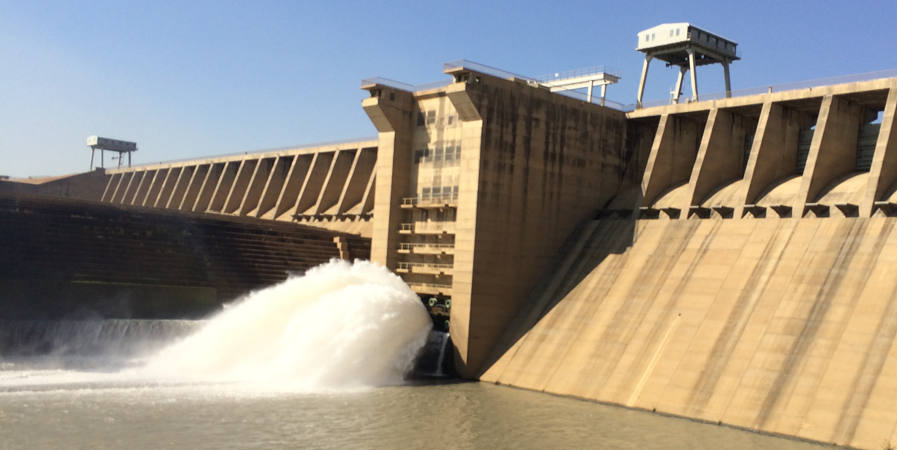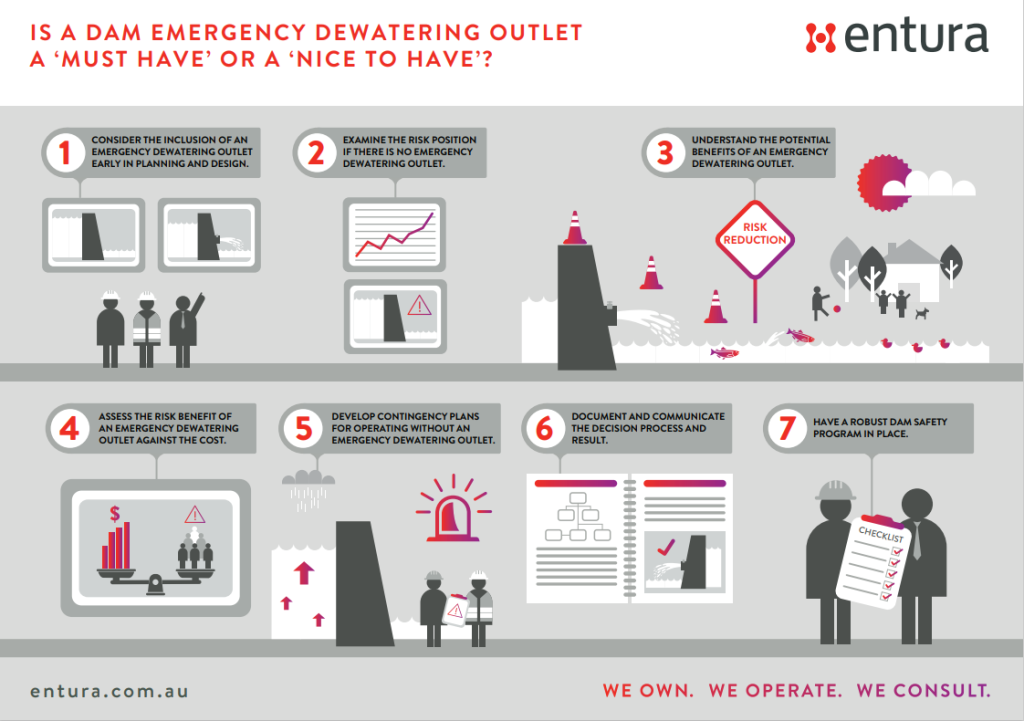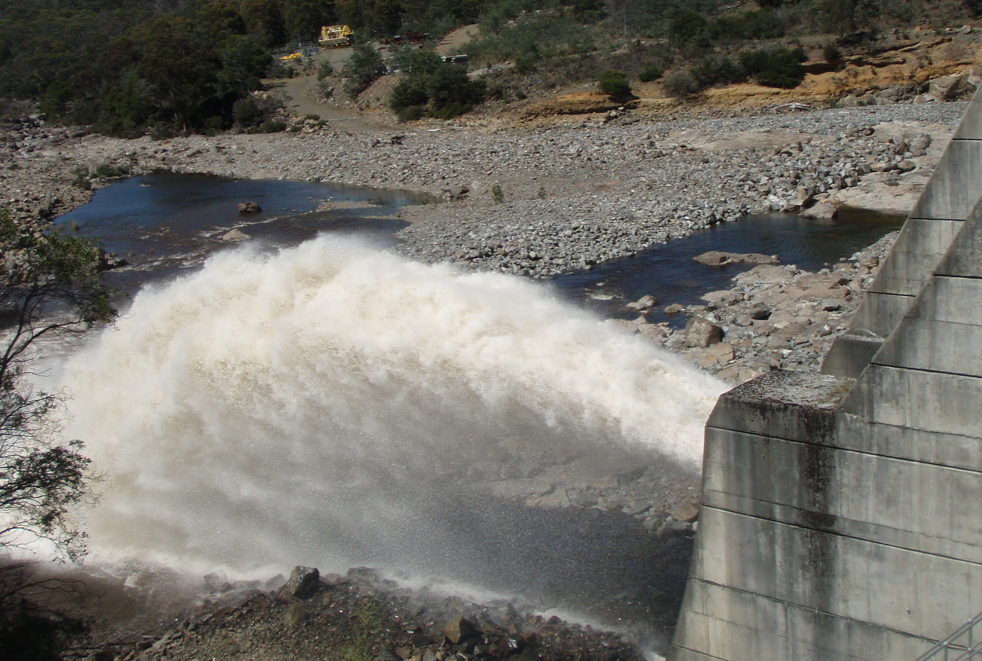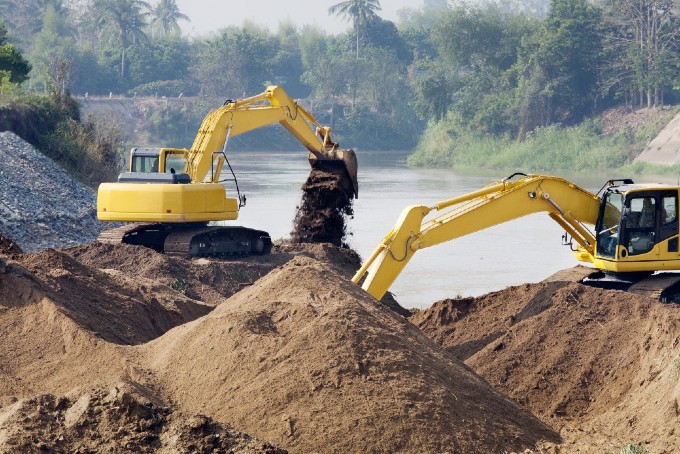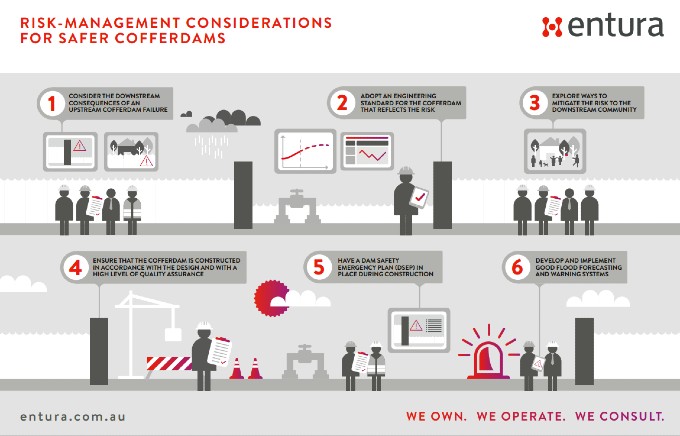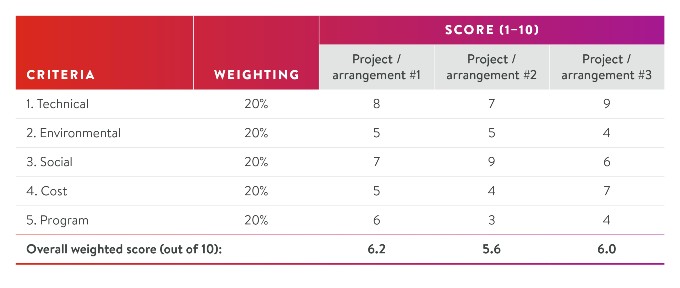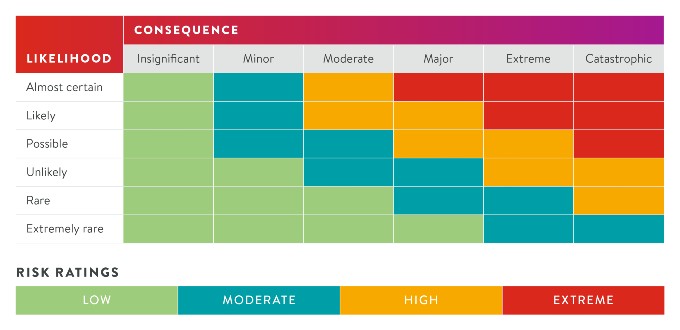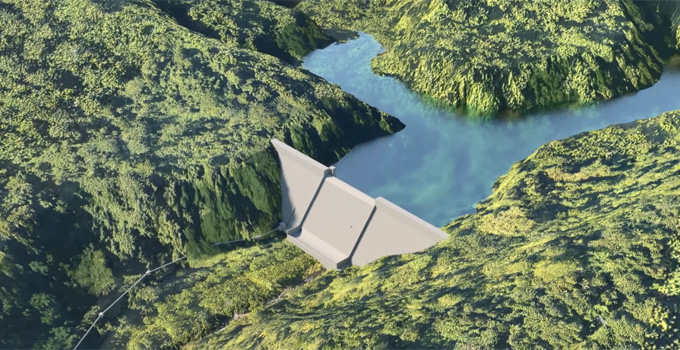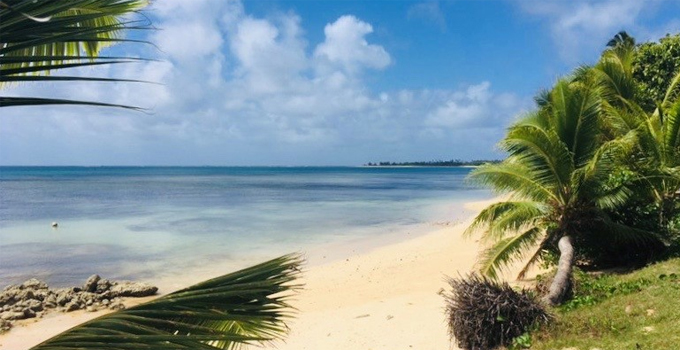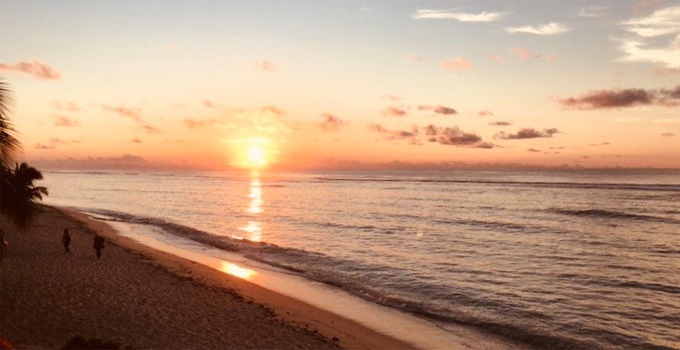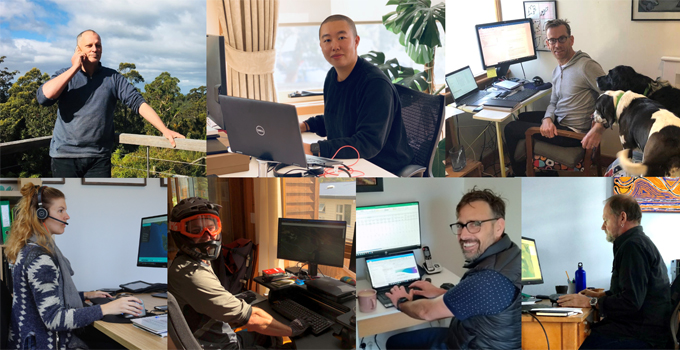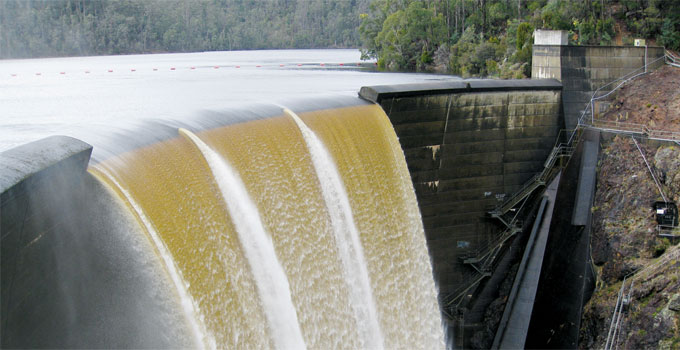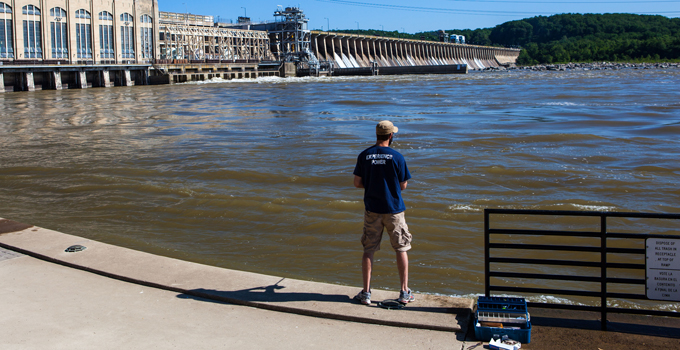New technologies are important tools, but they need to be used properly
Entura’s Technical Director (Water), Richard Herweynen, recently attended the 2025 ICOLD Congress in Chengdu, China, themed ‘Common Challenges, Shared Future, Better Dams’. Here he shares his observations on the state of play in the international dams industry – and the opportunities emerging with artificial intelligence and automation.
My first ICOLD Congress was in Beijing, China in 2000. I was presenting some finite element analysis work that I had done on Gordon Dam, a 140m-high concrete arch dam in Tasmania. The analysis was being used to help predict and explain some cracks that had formed at the base of the downstream face of the concrete shell, roughly normal to the foundation, during first filling. In the 1980s, an attempt had been made to model the crack using finite element modelling, but with little success due to the coarseness of the mesh. However, by the late 1990s, computing power had increased and finite element programs had improved, providing the capability to construct more detailed finite element models, which were able to predict and explain the cracking that had occurred.
Dr Sergio Giudici, the designer of Gordon Dam, was my mentor on this finite element analysis, and he reinforced these principles:
- It is important to verify the input data to make sure the model represents, as well as possible, the actual dam parameters.
- Results should be validated using alternative techniques to give the engineer confidence in the results that the model is producing (i.e. structural hand calculations still have a place).
- Complexity should be built into these models only gradually, so that the engineer can see the impact of changes and determine whether they are reasonable.
These same principles are true for many complex engineering models and when setting up calculation spreadsheets or similar.
Now, 25 years on, I have had the privilege of attending the 2025 ICOLD Congress in Chengdu, China. At this Congress, there was much talk about the importance of dams in society for water security, the growing role dams and reservoirs play in providing resilience to climate change and the energy transition, the importance of balancing economic benefits and environmental needs, and – in all of this – the importance of ensuring that our dams are safe for communities downstream.
We have discussed many of these themes before – and they remain highly important; however, one thing I took away from ICOLD 2025 in particular was how China is embracing technology and advancing a ‘Smart Dam’ initiative.
New technologies and smarter dams
One could say that our industry has always been building smart dams, but China’s ‘Smart Dam’ concept is about using the full power of current technologies to construct, monitor and operate dams in smarter ways, and to use technologies to predict and adapt to changing conditions.
The CHINCOLD Workshop on Digital and Intelligent Technologies for Dam Construction, Operation and Maintenance, which occurred during ICOLD 2025, gave a glimpse of what may be possible.
Many projects utilise 3-dimensional digital models and building information modelling (BIM). However, the concept of having a digital twin of the dam, replicating every aspect of the physical dam in a digital form, opens the door to many possibilities, especially in light of the advent of artificial intelligence (AI).
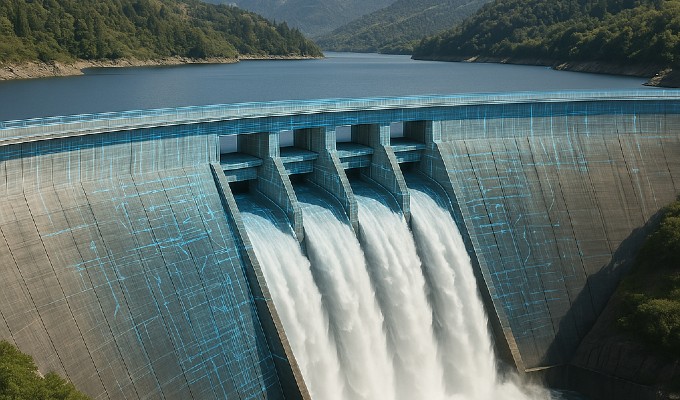
Artificial intelligence and machine learning
Many organisations and nations have been cautious about AI, but China is increasingly adopting it to improve construction practices in dam engineering, improve monitoring and surveillance of dams, and to help adapt to extreme events as they occur.
Machine learning (ML), an element of AI, enables computers to learn from data without being explicitly programmed. ML algorithms analyse data, identify patterns, and make predictions or decisions, improving their performance over time and with more data. There are no doubt many engineering applications where ML could be used to help improve predictive modelling or optimisation, and to make these more efficient. However, the same principles that were important when we were beginning to embrace larger, more refined finite element models with the advent of faster computing remain true here:
- We must verify the input data that machine learning is utilising to ensure we don’t get ‘garbage in equals garbage out’.
- Results need to be validated. AI needs to be trained correctly, and we need experts involved at this stage to ensure that the outputs from AI are correct.
- Complexity, or the full power of technology, should be added incrementally, to provide progressive confidence in the outcomes.
Engineering is the application of science, and therefore it is critical for every engineer to understand the fundamental principles and how to apply them. The complex computer programs used for a lot of engineering modelling can become ‘black boxes’, and practitioners risk diluting or losing their understanding of the fundamental principles behind the models, and hence their ability to validate the results.
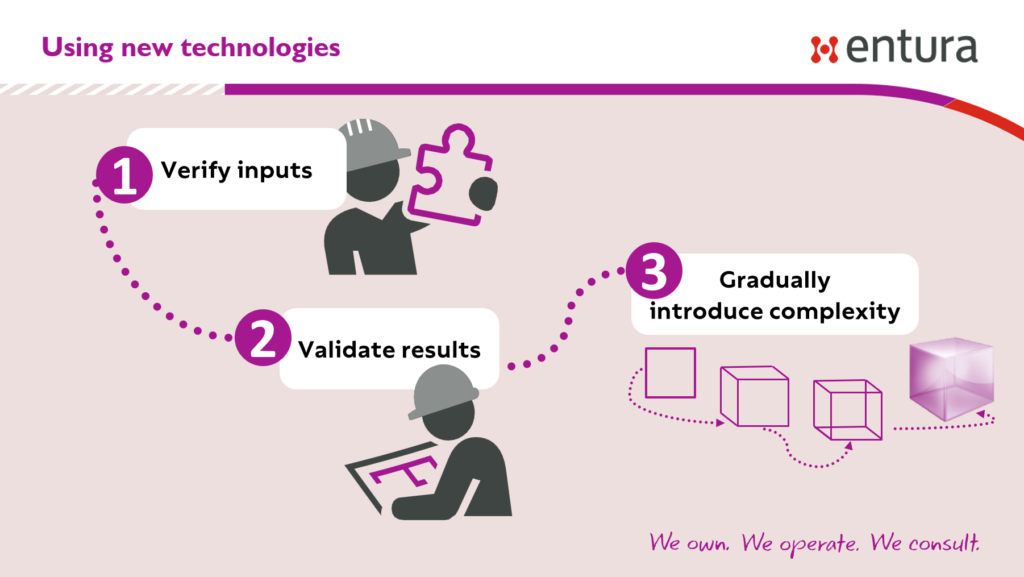
Automation brings a step change in efficiency and accuracy
At the ICOLD Congress in 2000, I co-authored a paper for the international symposium on concrete-faced rockfill dams (CFRD) entitled ‘Hydro Tasmania experience in concrete-faced rockfill dams – past, present and future’. There is no doubt that Hydro Tasmania has a strong history in CFRD, with Cethana Dam playing an important role in the development of the modern, high CFRD.
In 2000, however, the future in CFRD that we envisaged did not include unmanned construction equipment with automatic quality control feedback loops. At the 2025 CHINCOLD Workshop on Digital and Intelligent Technologies for Dam Construction, Operation and Maintenance, a presentation was given by Wang Jiajun from Tianjin University on intelligent unmanned roller systems to compact rockfill dams. Unmanned rolling compaction (URC) systems involve three core technology modules: (1) intelligent perception, (2) autonomous planning and decision making, and (3) intelligent control. These systems use automated driving technology to control the rolling process on earth and rockfill dams, improving productivity and quality. They can accurately control compaction parameters such as passes, speed, vibration and lift thickness. URC systems also enable continuous monitoring and real-time feedback for quality control, reducing human error and improving overall project performance. This automated technology was used on the 295m-high, 1.57km-long Lianghekou hydropower dam in China, with a total fill volume of 43 million m3.
The changing face of dam engineering
With AI and automation, the scope for embracing new technology in dam engineering is growing fast. It is clear that there are significant benefits that could be realised for dam design, construction, operation, dam safety and emergency response – and there’s a role for these advanced technologies at all of the stages of the life cycle of a dam. A degree of caution is appropriate and necessary, but caution should not be a reason to refuse to engage with the new technologies available to our industry.
However, with more sophisticated models – such as digital twins – being created of our dams, it is important to ensure we maintain the guiding engineering principles of verifying input data, validating models for correctness, and building complexity gradually. By doing this, we can provide the necessary assurance and confidence in our increasingly sophisticated and evolving tools.
ABOUT THE AUTHOR
Richard Herweynen is Entura’s Technical Director – Water. He has more than three decades of experience in dam and hydropower engineering, working throughout the Indo-Pacific region on both dam and hydropower projects. His experience covers all aspects including investigations, feasibility studies, detailed design, construction liaison, operation and maintenance and risk assessment for both new and existing projects. Richard has been part of a number of recent expert review panels for major water projects. He participated in the ANCOLD working group for concrete gravity dams and was the Chairman of the ICOLD technical committee on engineering activities in the planning process for water resources projects. Richard has won many engineering excellence and innovation awards (including Engineers Australia’s Professional Engineer of the Year 2012 – Tasmanian Division), and has published more than 30 technical papers on dam engineering.
Planning for the future – the challenges of dam inspection and maintenance
No dam is ‘maintenance free’. Without appropriate maintenance and refurbishment at the right times, a dam may not be able to fulfil its function safely for the full length of its design life (which could be more than a century).
This presents many challenges for asset owners. To keep the dam operating as the designer intended – and get the most out of the original investment over the long term – owners will need to develop and implement a suitable operations and maintenance manual aligned with the asset management plan and reflecting a ‘whole of life’ strategy. These plans will need to consider the unique characteristics of each dam and cover all the relevant issues. And there are many!
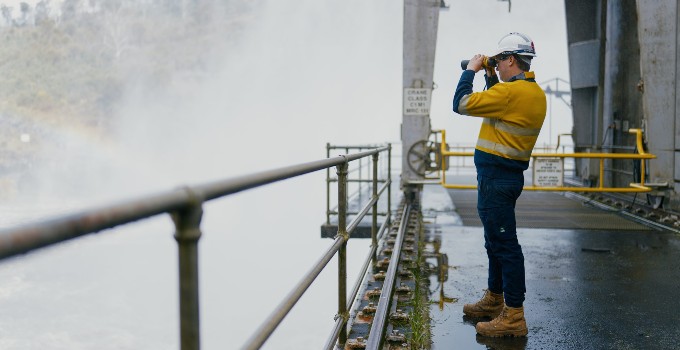
Dams consist of a number of different elements. There are the main civil engineering components including the wall that holds back the water and the spillway – but there could also be mechanical elements (pipework, valves and gates) and electrical elements (power supply to lights, valves, gate motors and control systems). Each of these elements will have its own operational and maintenance requirements and different lifecycle duration. Ideally, all this detail needs to be captured in the operation and maintenance manual (as recommended by ANCOLD guidelines) and in an asset management plan.
Civil components
The civil components of dams have the longest life span, typically more than 100 years if well constructed and maintained. Common maintenance items that need to be regularly addressed include:
- Vegetation management
Trees and bushes will readily grow in earthfill and rockfill embankments. Regular control (e.g. annually) is necessary to ensure that roots don’t grow through the fill and initiate leaks through the embankment. Mowing the grass on the downstream face of the earthfill embankment and downstream contact is necessary so that the condition of the face can be observed. Even concrete gravity and concrete arch dams will require vegetation control along the downstream face contact with the foundation so that the dam can be easily viewed in routine inspections.
- Surface water drainage
Dam construction typically affects natural drainage lines, which is why surface water drains are a common feature around and on dams – such as along the groins (where the dam wall intersects with natural ground), along berms in embankment dams, along benches, at the top of cuttings, and along access tracks. Drains will need regular inspection for both erosion and blockage due to sediment or vegetation.
- Foundation drain cleaning
Concrete gravity dams and concrete arch dams typically have drains drilled into the rock foundations to relieve uplift pressures and help maintain stability of the wall. Over time, silt or iron-rich slime can build up as a byproduct of bacterial growth in the drains, reducing effectiveness. These drains typically require 5-yearly high-pressure flushing. Cleaning will also be needed for drains underneath spillways founded on rock and cut slopes in rock.
- Protection of the dam safety monitoring system
Protecting the dam safety monitoring system requires a range of regular activities. These include cleaning and clearing vee-notch seepage monitoring weirs, checking survey monitoring pillars and targets, and checking the calibration of level monitoring and indication devices, such as reservoir-level sensors, piezometers, tiltmeters and inclinometers. Regular functional testing will also need to be carried out on the alarming and tripping devices that form the primary protection elements of the dam, including spillway gates and scour valves.
- Clearing of trash racks
Outlet works usually have trash racks to stop debris entering the pipework and causing blockages. It’s important to check that the build-up of debris is tolerable and that any hydraulic losses won’t affect operations. Assessing and removing the debris isn’t easy, as the trash racks are often accessible only by remotely operated vehicles (ROVs) or by divers. Before the inspection, the outlet will typically need to be closed and isolated.
Inspection-driven longer term maintenance will also be required for particular elements of the dam, ideally addressing repair items promptly to minimise damage and the cost of future repairs if left untreated. For example, concrete repairs may be needed to address erosion in stilling basins and spillway chutes, or spalling of concrete due to reinforcement corrosion or freeze/thaw damage.
While regular inspections should be undertaken to detect slow deterioration, special inspections following major events – such as floods or earthquakes – should also be part of the operations and maintenance plan. Given that the key areas for inspection are often difficult to access safely, use of UAVs (e.g. to inspect a spillway crest and chute) or ROVs (e.g. to undertake underwater inspections or scanning of stilling basins, plunge pools or riverbed scour) should be considered.
When special inspections identify the need for repairs, the time is right to consider whether the dam’s design or surveillance could be improved to increase resilience for a similar event in future. For example, a higher strength concrete overlay may treat erosion of a spillway chute and increase its resistance to future erosion.
Mechanical components
Mechanical items such as steel or cast-iron pipework can also often last up to 100 years if adequately protected from corrosion. Concrete and cement mortar are very effective for this purpose as the alkaline environment provided by the cement paste provides a very low corrosion environment. Key to the effectiveness of this protection is ensuring that the cement remains in intimate contact with the steel or iron. This will require regular inspections and timely repairs. Where concrete protection is not practical, paint systems can be very effective for up to about 20 years. A suitable inspection regime will be needed so that any areas where the paint has deteriorated can be detected and patched.
Mechanical items such as valves and gates typically have an effective life of around 50 years; however, they need to be exercised regularly to keep them able to work on demand. This is not an issue of the parts wearing out from use; rather, it’s the risk of them seizing due to lack of use. Regular lubrication of bearings, gearboxes and trunnions needs to be included as part of the maintenance of these items. This is particularly important in scour valves and spillway gates that may have a very low frequency of use during normal operations but are there for use in emergencies. The wire ropes commonly used to hoist spillway gates open will need even more frequent replacement, at approximately every 20 years.
Electrical components
Electric motors are commonly used to drive the winches hoisting spillway gates or driving the shafts to open valves. Associated with the motors will be switchboards and power supply systems, typically including grid power supply and backup diesel generators. The typical life of these components is around 25 years. As with the mechanical components, lack of operation can lead to premature failure, so a regular regime of exercise is necessary to ensure maximum reliability and life.
The programable logic controllers (PLC) that are used to automate operations, allow remote operations and generate alarms will have a typical life of only 10–12 years due to changes in programming languages and rapid evolution of the hardware.
Getting the most out of life
As we’ve seen, regular maintenance is fundamental for keeping all the components of a dam operating as intended and maximising their lifespan – whether that’s 10 years or 100. This maintenance, including the exercising of the mechanical and electrical components, needs to be clearly documented in the operations and maintenance manual and recorded in an asset management system. The asset management plan must allow for regular maintenance and also budget appropriately for replacement or refurbishment when any component of the dam is due for retirement.
At Entura, we believe in getting the most out of every piece of infrastructure because that’s good for our clients, communities and the planet. With a solid regime of inspection and maintenance, all the parts of your dam will be on the strongest path to a long, reliable and sustainable life.
If you’d like to talk with us about inspecting and maintaining your dam/s, contact Phil Ellerton, Paul Southcott, or Richard Herweynen.
About the author
Paul Southcott is Entura’s Senior Principal – Dams and Headworks. Paul has an outstanding depth of knowledge and skill developed over more than 3 decades in the fields of civil and dam engineering. He is a highly respected dams specialist and was recognised as Tasmania’s Professional Engineer of the Year in Engineers Australia’s 2021 Engineering Excellence Awards. Paul has contributed to many major dam and hydropower projects in Australia and abroad, including Tasmania’s ‘Battery of the Nation’, the Tarraleah hydropower scheme, Snowy Hydro, and numerous programs of work for water utilities including SeqWater, Sun Water and SAWater. His expertise is a crucial part of Entura’s ongoing support for upgrade and safety works for Hydro Tasmania’s and TasWater’s extensive dams portfolios. Paul is passionate about furthering the engineering profession through knowledge sharing, and has supported many young and emerging engineers through training and mentoring.
‘Dams for People, Water, Environment and Development’ – some reflections from ICOLD 2024
Entura’s Amanda Ashworth (Managing Director) and Richard Herweynen (Technical Director, Water) recently attended the International Commission on Large Dams (ICOLD) 2024 Annual Meeting and International Symposium, held in New Delhi. Amanda presented on building dam safety capability, skills and competencies, while Richard presented on Hydro Tasmania’s risk-based, systems approach to dam safety management, and the importance of pumped hydro in Australia’s energy transition.
Here they share some reflections on ICOLD 2024 …

Richard Herweynen – on the value of storage, ‘right dams’, and stewardship
At ICOLD 2024 we were reminded again that water storages will be critical for the world’s ability to deal with climate change and meet the growing global population’s needs for food and water. We can expect greater climate variability and therefore more variability in river flows, which means that more storage will be needed to ensure a high level of reliability of water supply. Without more water storages to buffer climate impacts, heavily water-dependent sectors like agriculture will be impacted.
To slow the rate of climate change, we must decarbonise our economies – but without significant energy storage, it will be difficult to transition from thermal power to variable renewable energy (wind and solar). Pablo Valverde, representing the International Hydropower Association (IHA), said at the conference that ‘storage is the hidden crisis within the crisis’. There was a lot of discussion at ICOLD 2024 about pumped hydro energy storage as a promising part of the solution. It is also important, however, to remember that conventional hydropower, with significant water storage, can be repurposed operationally to provide a firming role too. Water storage is the biggest ‘battery’ of the world and will be a critical element in the energy transition.
With the title of the ICOLD Symposium being ‘Dams for People, Water, Environment and Development’, I reflected again on the need for ‘right dams’ rather than ‘no dams’. ‘Right dams’ are those that achieve a balance among people, water, environment and development. In the opening address, we were reminded of the links between ‘ecology’ and ‘economy’ – which are not only connected by their linguistic roots but also by the dependence of any successful economy on the natural environment. It is our ethical responsibility to manage the environment with care.
When planning and designing water storages, we must recognise that a river provides ecological services and that affected people should be engaged and involved in achieving the right balance. If appropriate project sites are selected and designs strive to mitigate impacts, it is possible for a dam project’s positive contribution to be greater than its environmental impact, as was showcased in number of projects presented at the ICOLD gathering. Finding the balance is our challenge as dam engineers.
The president of ICOLD, Michel Lino, reminded delegates that the safety of dams has always been ICOLD’s focus, and that there is more to be done to improve dam safety around the world. At one session, Piotr Sliwinski discussed the Topola Dam in Poland, which failed during recent floods due to overtopping of the emergency spillway. Sharing and learning together from such experiences is an important benefit of participating in the ICOLD community.
Alejandro Pujol from Argentina, who chaired one of the ‘Dam Safety Management and Engineering’ sessions, reflected that in ICOLD’s early years the focus was on better ways to design and construct new dams, but the spotlight has now shifted to the long-term health of existing dams. It is critical that dams remain safe throughout the challenges that nature delivers, from floods to earthquakes. In reality, dams usually continue to operate long beyond their 80–100 year design life if they are structurally safe, as evidenced in the examples of long-lived dams presented by Martin Wieland from Switzerland. He suggested that the lifespan of well-designed, well-constructed, well-maintained and well-operated dams can even exceed 200 years. As dam engineers, no matter the part we play in the life of a dam, we have a responsibility to do it well.
From my conversations with a number of dam engineers representing the ICOLD Young Professional Forum (YPF), and seeing the progress of this body within the ICOLD community, I believe that the dam industry is in good hands – although, of course, there is always more to be done. I was pleased to see an Australian, Brandon Pearce, voted onto the ICOLD YPF Board.
Another YPF member, Sam Tudor from the UK, reminded us in his address of the importance of knowledge transfer, the moral obligation we all have especially to the downstream communities of our dams, and our stewardship role. He was referencing his experience of looking after dams that are more than 120 years old – all built long before he was born. Many of our colleagues across Entura and Hydro Tasmania feel this same sense of responsibility and pride when we work on Hydro Tasmania’s assets, which were built over more than a century and have been fundamental to shaping our state’s economy and delivering the quality of life we now enjoy. It is up to all of us to carry the positive legacy of these assets forward with care and custodianship, for the benefit of future generations.
Amanda Ashworth – on costs and benefits, dam safety, and an inclusive workforce
Like Richard, I found much food for thought at ICOLD 2024. For me, it reinforced the need to accelerate hydropower globally, particularly in places where the total resource is as yet underdeveloped. To do so, we will need regulatory frameworks that support success – such as by monetising storage and recognising it as an official use – and administrative reforms that ease the challenges of achieving planning approvals, grid connection agreements and financing for long-duration storage. We must encourage research and development to move our sector forward: from multi-energy hybrids to advanced construction materials and innovations to improve rehabilitation.
In particular, I’ve been reflecting on how our sector could extend our thinking and discourse about the impacts and benefits equation beyond the broad answer that dams are good for the net zero transition. How can we enact and communicate the many other potential local environmental and social benefits and long-term value from dams?
Much of the world’s existing critical infrastructure came at a significant financial expense as well as social and environmental costs – so it is our obligation to pay back that investment by maximising every dam’s effective life. When we invest in extending the lifespan of dam infrastructure through effective asset management and maintenance, and when we maximise generation or the value of storage in the market, we increase the ‘return on investment’ against the financial, social and environmental impacts incurred in the past.
Of course, the global dams community must continue to prioritise dam safety and work towards a ‘safety culture’. I was pleased to hear Debashree Mukherjee, Secretary of the Ministry of Jal Shakti, celebrate the progress on finalising regulations across states to enact India’s Federal Dam Safety Act and establishing two centres of excellence to lift capacity across the nation. Dam safety depends on well-trained people with the right skills and competencies to comply with evolving standards, apply new technologies, and respond effectively to changing operational circumstances and demands.
I also enjoyed hearing from ICOLD’s gender and diversity committee on its progress, including updates from around 14 nations on their efforts to build a more inclusive renewable energy and dams workforce. This is front of mind for us, as we step up Entura’s own focus and actions on gender equity throughout our business this year.
The challenges facing our dams community – and our planet – are enormous, but there is certainly much to be excited about, and we look forward to continuing these important conversations over the next year.
From Richard, Amanda and Entura’s team, many thanks to the Indian National Committee on Large Dams (INCOLD) for organising and hosting this year’s ICOLD event, supporting our sector to build international professional networks, and facilitating the sharing of experiences and knowledge across the globe – all of which are so important for growing the ‘ICOLD family’ and supporting a safer, more resilient and more sustainable water and energy future.
Designing dams for an uncertain climate future
Dams are critical infrastructure for water supply, irrigation, energy production, flood protection, or multiple purposes. They are usually designed to last at least 100 years, yet with good maintenance and appropriate dam safety practices, dams can continue to perform as designed for centuries. But what about climate change? The circumstances in which a dam operates may be very different in the coming decades – and exactly how these changes will play out in different regions is impossible to predict with certainty.
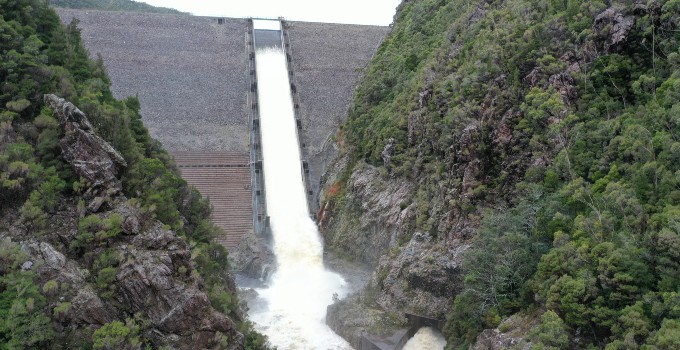
Dams are designed to continue to perform safely in extreme events, such as major floods and earthquakes, to avoid the high economic, environmental, and social consequences of dam failure. When the consequence has the potential to be extreme, the flood that the dam will need to be designed for is, in Australia, the ‘Probable Maximum Flood’ (PMF), while in some other parts of the world it is often the 1:10,000 annual exceedance probability (AEP) flood.
But even if standards or guidelines are clear about the ‘return period’ of flood that the dam should be designed for – is it still as simple as reading the magnitude of the flood discharge off the flood frequency curve as has been done in the past? These days, it is not so simple.
Exploring the inherent uncertainty in the flood frequency curve
Part of the reason for more complexity is that we have greater computing power today to be able to explore the uncertainty in our flood frequency curve. Predicting extreme flood events (such as the PMF) is not an exact science and involves many variables which are often not well characterised. As a result, there is significant uncertainty in predicting floods, particularly extreme floods. If this uncertainty is presented, the flood frequency curve is no longer a single line but a band. The more extreme the flood event, the wider the uncertainty band. Although the flood frequency curve shown below is fitted directly to measured flow data, the uncertainty bounds are similar regardless of the approaches implemented to derive the flood frequency curves.
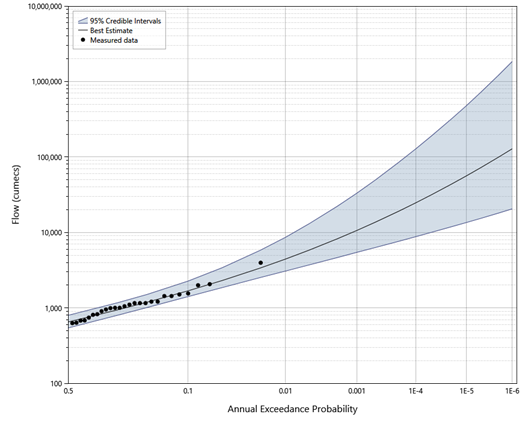
So, what flood should the dam be designed for? Should it be the median best estimate, or should it take into account some of the uncertainty? This is the first challenge, and it is there whether we consider climate change or not.
Adding the extra uncertainty of climate change
Climate change doesn’t stand still. This adds even more complexity to the flood prediction challenge. What is the impact of climate change on extreme events now, and what will it be as time goes by? Numerous studies of climate change impacts suggest that there will be greater variability in extreme temperatures and extreme rainfall, and that extreme events may become more frequent. As a result, the magnitude of extreme flood events, for which dams must be designed, will likely increase with time.
Changes in the magnitude or frequency of extreme floods will depend on projections of future temperature, emission scenarios and the models used to simulate the changes. Even with a ‘middle of the road’ emission scenario (such as the IPCC’s SSP2–4.5 scenario) that results in a median global temperature increase of 3 °C (compared to preindustrial temperature baseline) by the end of this century, there could be a 23% increase in 24-hour extreme rainfall depth. But this is only one of the scenarios; some are more extreme, some show less increase, some show more. The increase is greater for higher emission scenarios and for shorter duration storms. Ultimately, an increase in rainfall depths results in an increase in flood magnitudes.
Guidance on climate uncertainty in dam design is limited
Currently, most standards and guidance documents are silent on how climate change should be applied in the design of spillway capacities for dams to safely pass these extreme flood events. However, the International Commission on Large Dams (ICOLD) Bulletin 142 on the Safe Passage of Extreme Floods (2012) indicates that there is uncertainty associated with the resulting flood estimates because of uncertainties in the hydrometeorological data used in determining the design flood. In addition, there may be changes in future methods for the development of design floods, changes in the future condition of the catchment (e.g. due to deforestation), and changes in rainfall conditions due to climate change. All of these have the potential to increase the magnitude of the future design flood.
This 2012 bulletin encourages strategies for planning spillway arrangements with consideration of floods exceeding the design flood (i.e. checking the robustness of the spillway flood design capacity from a dam safety risk perspective). This demonstrates that more than a decade ago the international dam engineering community was already promoting consideration of climate change resilience when designing new dams and upgrades of existing dams.
The more recent ICOLD Bulletin 170 on Flood Evaluation and Dam Safety (2018) states that although projected changes in climate are generally expected to increase flood risk in many parts of the world, understanding the impact on flood risk is subject to considerable uncertainty. It states that one of the main impacts of climate change will be to increase the uncertainty associated with the estimation of extreme floods.
There are tools available now that can be used to look at climate change impacts on extreme rainfall events, mainly around changing rainfall inputs to rainfall–runoff models based on climate advice, or else through using stochastic climate generators. However, this 2018 ICOLD bulletin also warns about complex numerical modelling and the ‘black box effect’ of accepting results without verification or critical consideration. It stresses that the intrinsic hydrological uncertainty will always remain no matter how clever or complex the numerical modelling.
Practical suggestions for dealing with uncertainty
Given that dams are designed for the long-term, it is crucial to consider the uncertainty of floods and the potential impacts of climate change. Climate impacts are being discussed increasingly by dam owners, dam engineers and dam regulators – and guidance on how best to deal with climate change will come eventually. This review article, ‘Climate change impacts on dam safety’, provides a good summary and some thoughts about approaching the issues in a framework based on dam safety risk.
In the meanwhile, we’ve developed some practical suggestions for dealing with intrinsic hydrological uncertainty and the increased uncertainty due to climate change, whether you’re working on new dams or upgrades to existing dams:
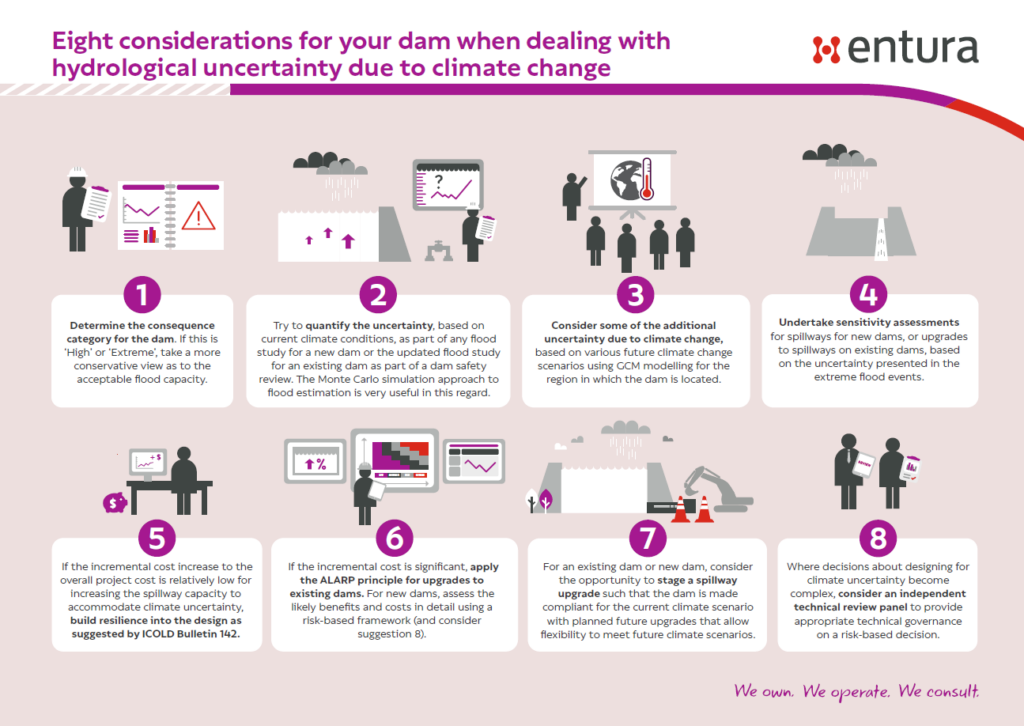
- 1. Determine the consequence category for the dam. If this is ‘High’ or ‘Extreme’, take a more conservative view as to the acceptable flood capacity.
- 2. Try to quantify the uncertainty, based on current climate conditions, as part of any flood study for a new dam or the updated flood study for an existing dam as part of a dam safety review. The Monte Carlo simulation approach to flood estimation is very useful in this regard.
- 3. Consider some of the additional uncertainty due to climate change, based on various future climate change scenarios using GCM modelling for the region in which the dam is located.
- 4. Undertake sensitivity assessments for spillways for new dams, or upgrades to spillways on existing dams, based on the uncertainty presented in the extreme flood events.
- 5. If the incremental cost increase to the overall project cost is relatively low for increasing the spillway capacity to accommodate climate uncertainty, build resilience into the design as suggested by ICOLD Bulletin 142.
- 6. If the incremental cost is significant, apply the ALARP principle for upgrades to existing dams. For new dams, assess the likely benefits and costs in detail using a risk-based framework (and consider suggestion 8 below).
- 7. For an existing dam or new dam, consider the opportunity to stage a spillway upgrade such that the dam is made compliant for the current climate scenario with planned future upgrades that allow flexibility to meet future climate scenarios.
- 8. Where decisions about designing for climate uncertainty become complex, consider an independent technical review panel to provide appropriate technical governance on a risk-based decision.
If you would like to speak with us about how climate change could affect your new or existing dam, please contact Richard Herweynen or Prafulla Pokhrel.
About the author
Richard Herweynen acknowledges the input of his colleagues Prafulla Pokhrel (Principal Consultant, Hydrology) and Paul Southcott (Senior Principal, Dams and Headworks) in writing this article.
Richard is Entura’s Technical Director, Water. He has more than three decades of experience in dam and hydropower engineering, and has worked throughout the Indo-Pacific region on both dam and hydropower projects, covering all aspects including investigations, feasibility studies, detailed design, construction liaison, operation and maintenance and risk assessment for both new and existing projects. Richard has been part of a number of recent expert review panels for major water projects. He participated in the ANCOLD working group for concrete gravity dams and was the Chairman of the ICOLD technical committee on engineering activities in the planning process for water resources projects. Richard has won many engineering excellence and innovation awards (including Engineers Australia’s Professional Engineer of the Year 2012 – Tasmanian Division), and has published more than 30 technical papers on dam engineering.
MORE THOUGHT LEADERSHIP ARTICLES
Dams are crucial to climate change response and the energy transition
At the recent ICOLD meeting in Gothenburg, Sweden, dam engineering experts from across the globe came together to share knowledge, discuss trends and issues, and engage with each other. One important topic of discussion was the role of dams in the international response to climate change and what that will mean for the dams industry. Richard Herweynen, Entura’s Technical Director, Water, shares his thoughts on this topic here …

Why will dams play a critical role?
Three major reasons why dams will be crucial in the climate change response and energy transition are water security, dispatchability of electricity, and tailings storage.
- Water storages will be vital to provide the same level of water security
Water security is essential for humanity. With greater hydrological variability due to climate change, more storage will be needed to provide the same level of security of water, food and energy. Water storage is a fundamental protection from the impacts of a changing climate, safeguarding the supply of water, and the water–food–energy nexus, even during extended drought.
The effects of climate change are predicted to increase and to result in greater magnitude and frequency of hydrological extremes, such as prolonged droughts and significant floods. With prolonged drought, inflows to storages will reduce. If demand remains the same, stress on existing water storages will increase.
Water storages are used to regulate flows and manage this variability: storing water when there are high inflows (or floods) and then using this stored water during low inflows (or droughts). Dams are used to create these vital water storages.
- Hydropower and pumped hydro energy storage (PHES) are critical for the energy transition
A key response to climate change is the decarbonisation of the electricity sector through renewable energy. Wind and solar power now offer the lowest cost of energy, have low ongoing operational costs, and emit the least greenhouse gases across their lifecycle – and therefore hold the greatest potential for rapid decarbonisation of the energy sector. Of course, wind and solar PV output vary according to the weather and the time of day – but the electricity market needs the supply of electricity to match demand, or for these renewables to be dispatchable.
Energy storage is the key to smoothing out the variability of renewable energy generated by solar and wind. The power and duration of the storage are the two key variables in determining the most suitable solution. Low-power, short-term storage is currently more cost-effective using batteries, but longer periods and larger power requirements are likely to rely on bigger storage options, such as pumped hydro energy storage (PHES) and traditional hydropower. Smoothing out the daily variability in renewables can be achieved effectively through pumped hydro. Dams are used to create the water storages used in both traditional hydropower and PHES.
- The transition to renewables will demand more minerals and metals
The global energy transition will demand a major increase in renewable energy technologies – which in turn will require more of the ‘critical energy minerals’ and metals. The rising need for minerals such as copper, aluminium, graphite, lithium and cobalt will not be able to be met by recycling and reuse alone. Therefore, extraction and storage of minerals from mining operations will be essential to sustain the renewable energy transition.
According to a report by the World Bank Group, the production of minerals such as graphite, lithium, and cobalt could increase by nearly 500% by 2050 to meet the escalating demand for clean energy technologies. It is estimated that over 3 billion tonnes of minerals and metals will be necessary for the deployment of wind, solar, geothermal power and energy storage, all of which are vital for achieving a sustainable future with temperatures below 2°C.
However, this need for mining activity comes with a special responsibility for sustainable practices, including the proper management and storage of mining waste. Rock, soil and other by-products are left behind after the desired minerals have been extracted from the ore. Tailings facilities store this waste, playing a crucial role in mitigating the environmental impact of mining operations. Dams, in particular, are commonly used to create these facilities, as they provide an effective means of containing the waste.
Dams used in tailings facilities are designed to withstand the weight and pressure of the waste materials, prevent seepage of contaminants into the surrounding environment, and take into account factors such as stability, erosion control and water management. Dams that are well designed, constructed and monitored, adhering to stringent environmental and safety regulations, can help prevent the spread of mining waste into nearby water bodies, reducing the risk of water contamination and protecting aquatic ecosystems.
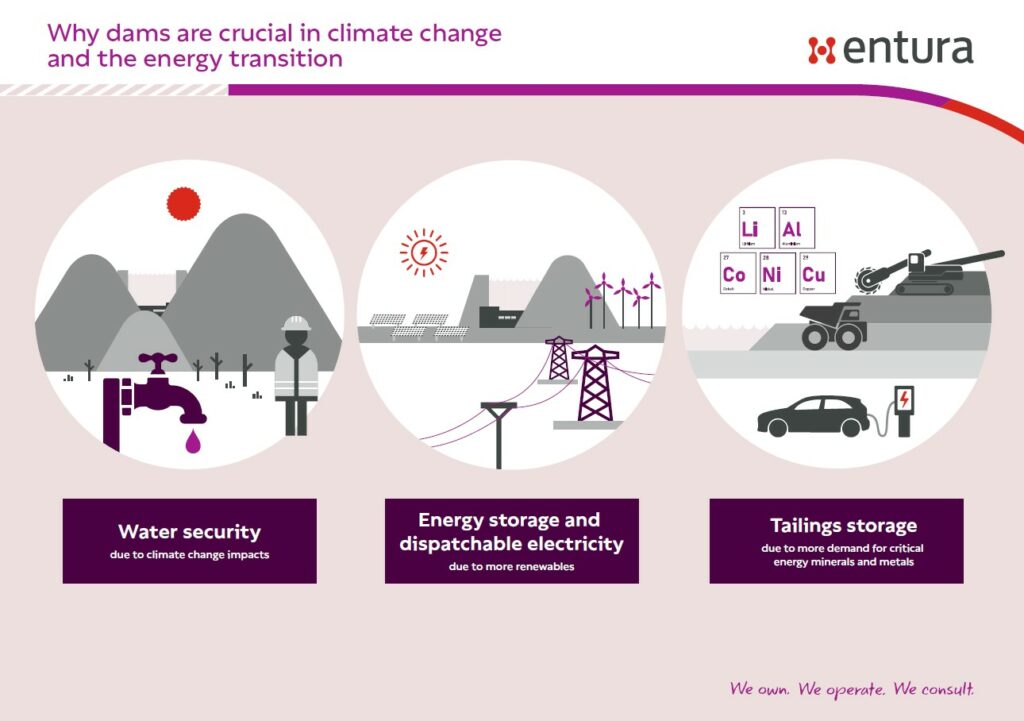
Working towards ‘good dams’
While there have certainly been some examples around the world of dams that have had adverse impacts, it is clear that dams will play a critical role in the international response to climate change and the decarbonisation of the energy sector. It’s therefore vital that dams are planned, constructed and managed appropriately and safely. With increasing understanding of impacts and far greater sophistication of internationally accepted sustainability protocols, it is now up to developers and planners to heed the lessons of the past and find the right dam sites for nature and communities.
It is important that we ensure the safety of existing dams as well as the safety of any new dams. Examples from around the world demonstrate the devastating consequences of dam failures. Safety must be every dam owner’s key concern, and should be managed through an active dam safety program.
Of course, the larger the portfolio of dams an owner is managing, the greater the demand on their resources; however, it is critical that dam safety risks for water storages and tailings facilities are managed appropriately across dam portfolios to protect downstream communities. The Portfolio Risk Assessment process increases the focus on potential failure modes and risk as drivers of the dam safety program and as the basis for deciding priorities for allocating operational and capital resources.
It will also be vital that dams engineers, owners and operators keep up to date with the latest developments in the dams industry worldwide through continuous learning and important global forums such as ICOLD.
If you’d like to talk with Entura about your water or dam project, contact Richard Herweynen.
About the author
Richard Herweynen is Entura’s Technical Director, Water. Richard has three decades of experience in dam and hydropower engineering, and has worked throughout the Indo-Pacific region on both dam and hydropower projects, covering all aspects including investigations, feasibility studies, detailed design, construction liaison, operation and maintenance and risk assessment for both new and existing projects. Richard has been part of a number of recent expert review panels for major water projects. He participated in the ANCOLD working group for concrete gravity dams and is the Chairman of the ICOLD technical committee on engineering activities in the planning process for water resources projects. Richard has won many engineering excellence and innovation awards (including Engineers Australia’s Professional Engineer of the Year 2012 – Tasmanian Division), and has published more than 30 technical papers on dam engineering.
MORE THOUGHT LEADERSHIP ARTICLES
Planning sustainable water infrastructure in a changing world
In an already water-stressed world and a rapidly changing climate, water is increasingly precious. To manage and control this vital resource, we must create and maintain safe, reliable and sustainable water infrastructure – and such a challenge calls for good planning.
The International Commission on Large Dams is working towards releasing new guidance for water infrastructure planning – and Entura’s Richard Herweynen is a member of the Technical Committee looking to develop a new ICOLD Bulletin on planning. In this article, Richard explains the importance and evolution of planning approaches.
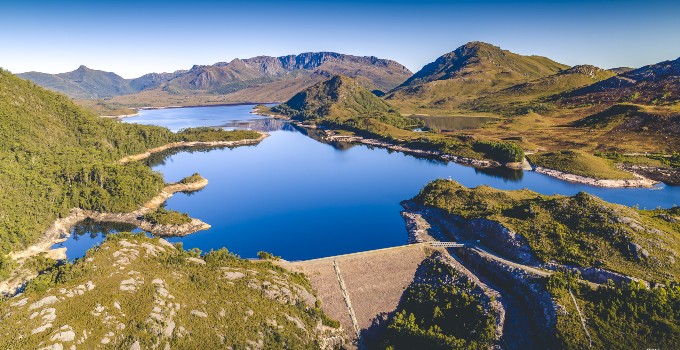
Water infrastructure projects deliver the dams, treatment plants, irrigation systems and distribution networks that provide water for homes, food production, industries and emergencies. They also create the structures integral for mitigating the effects of floods and droughts. But to maximise the benefits of this infrastructure, projects must be planned, engineered and managed for effectiveness, safety and sustainability.
These projects are far too important to approach in a haphazard way. Planning offers a structured, rational approach to solving problems – and it is the start of the ‘pipeline’ for addressing water resource needs and competing demands. In fact, for civil works programs, everything begins with planning.
Without a good plan, where are we?
Without careful planning, it can be difficult to achieve creative, cost-effective solutions to water needs. The planning stage helps decision-makers identify water resource problems, conceive solutions and evaluate the inevitably conflicting values inherent in any solution. Planning is best done by a team that brings together specialists in many of the natural, social and engineering sciences.
At the planning stage, all of the following points should be thought through:

Guidance for better planning
In 2007, I became the ANCOLD-nominated member on a new Technical Committee for the International Commission of Large Dams (ICOLD) entitled ‘Engineering Activities in the Planning Process for Water Resource Projects’. In 2009 we put forward a position paper setting out an ‘Improved Planning Process for Water Resource Infrastructure’ based on ‘comprehensive vision based planning (CVBP)’.
At the next ICOLD Annual Meeting in Sweden in June 2023, our committee will be meeting to work on an updated framework that takes into account the rapid change we’ve witnessed over the last decade and the many cross-cutting issues that are impacting the planning process, such as risk-informed decision-making, climate change, sustainable development, environmental concerns, and river basins/systems.
What is ‘comprehensive vision-based planning’ (CVBP)?
Before we talk about updates, let’s take a quick look at our existing approach to CVBP, as articulated in 2009.
CVPB is a comprehensive, transparent planning process based on a shared vision for sustainable water resource development. It aims to achieve a better ‘triple bottom line’ outcome, with optimum economic, social and environmental outcomes.
Whereas many past projects were planned on a case-by-case basis, CVBP looks beyond the immediate project to the broader regional vision and watershed goals (which may also cross national borders), taking projected changes in water supply and demand into account. It draws on integrated water resources management (IWRM) to consider multiple points of view about how to manage water and to view each water infrastructure project in relationship to the other existing infrastructure in the region.
CVPB also incorporates much greater attention to the realistic options and cost-benefits of mitigation of environmental impacts – and it draws in more interdisciplinary engineering, cost estimating, and stakeholder/community engagement.
CVBP is, therefore, a holistic, integrated and collaborative approach to planning and a much-improved pathway towards successful outcomes.
The 8 steps of CVBP
As currently articulated, CVBP has 8 defined steps – but it’s an iterative process in which steps 2 to 7 are repeated multiple times, as necessary. The 2009 ICOLD bulletin goes into much greater detail than we can in this article, but this will give you an overview:

Changes moving forward
It is time to update the planning process and guidance in the light of the rapid changes we are experiencing in our environment, innovations in technologies, and an increasing awareness of sustainability and ethics.
In the past, much water infrastructure has been planned within a reasonably near-term political and social lens and timeframe, and from a perspective of relative stability. But we know that change is constant and rapid, so our planning approaches need to shift to an even greater appreciation of uncertainty, risk and the intensifying potential for extreme events. There is also an urgent need to apply a deeper and broader awareness of the many considerations that make for greater environmental, social and economic sustainability.
Important factors here will be an uplift in stakeholder involvement and governance, a very clear focus on the costs and benefits that can’t easily be quantified or monetised, and reinforcement of the fundamental principle of ‘do no harm’.
It will also be important to take an adaptive approach to regional planning objectives, with a strong awareness of different regional and cultural values, goals, expectations, methodologies, financing arrangements and roles of government.
We should expand the planning scenarios to also explore non-structural options, dam removal plans, and scenarios based on failure modes. We also need to improve early data collection by finding and filling data gaps, improving the ways in which we preserve historical information, and improving data portrayal.
It is very important to involve the right people. Ideally, the planning team should be more than ‘multi-disciplinary’ or ‘interdisciplinary’. It should aspire to be ‘transdisciplinary’, in which all disciplines work seamlessly and collectively and achieve a level of insight that is ‘greater than the sum of its parts’.
This year, our Technical Committee will continue to build on some of these elements as we review and rearticulate CVBP, working towards a new ICOLD Bulletin to guide water infrastructure planning.
In a changing world, our approaches to infrastructure cannot stagnate. Designing, articulating and applying new planning frameworks is an important step towards creating and maintaining the sustainable, reliable water infrastructure our planet so urgently needs.
If you’d like to talk with Entura about your water or dam project, contact Richard Herweynen.
About the author
Richard Herweynen is Entura’s Technical Director, Water. Richard has three decades of experience in dam and hydropower engineering, and has worked throughout the Indo-Pacific region on both dam and hydropower projects, covering all aspects including investigations, feasibility studies, detailed design, construction liaison, operation and maintenance and risk assessment for both new and existing projects. Richard has been part of a number of recent expert review panels for major water projects. He participated in the ANCOLD working group for concrete gravity dams and is the Chairman of the ICOLD technical committee on engineering activities in the planning process for water resources projects. Richard has won many engineering excellence and innovation awards (including Engineers Australia’s Professional Engineer of the Year 2012 – Tasmanian Division), and has published more than 30 technical papers on dam engineering.
MORE THOUGHT LEADERSHIP ARTICLES
How robust is your emergency preparedness?
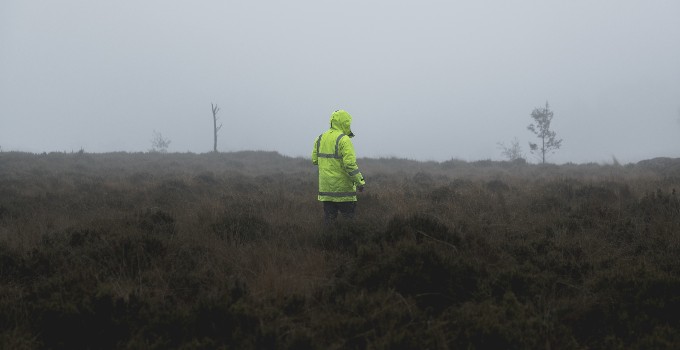
The old adage of ‘a company’s greatest assets are its people’ is never more true than in an emergency situation. The success of any emergency plan depends upon the skills, training and willingness of the people involved. It also relies on robust emergency preparation that takes as many scenarios as possible into account, and builds in a range of backups and alternatives for maximum agility and resilience.
All responsible dam owners have dam safety emergency plans (DSEP) which are carefully created and tailored to the needs of the company, its assets and its available resources.
If called upon in an extreme event, these plans will likely be pushed to their limit – but it’s vital that they perform as intended to reduce risk and consequences downstream.
The ultimate test of the emergency plan is how well it can cope with outages of power and/or communications. ‘Stress testing’ emergency plans for outage scenarios and implications is key to achieving a robust plan.
Power and communications outages
Where dams have moving parts, such as valves or floodgates, backups are needed to counter power outages. Are backup generators in place, or can a portable generator be brought to site at short notice? Is there a clear, safe access route to site during emergency conditions (e.g. not flooded or blocked by fallen trees)? Where this is not possible, can the valves or floodgates be operated by hand? A further question is whether these components are readily operable and exercised regularly.
Many dams are located in remote areas, and in some cases mobile phone reception is unreliable. In these situations, can satellite phones be made available? Landline phones may be available but depend on poles and lines remaining intact and operable during emergency conditions.
Communications are vital to ensuring the emergency plans are enacted under the direction of the incident controller. Where communications with remote resources are limited or not possible, those involved must fall back on their training and on lessons learnt from exercises and site-based, staged events involving scenarios of outages of power and communications. The DSEP can be updated with suggested actions for the on-site operators and emergency management team to follow in the worst-case scenario.
Alternative means of communication and access
In situations where check-in communications are required with those working remotely, alternative means must be considered in case of an outage of communications. In the absence of satellite phones, this could involve a messenger driving to site, but this relies on clear, safe access routes and careful consideration of the time required. In extreme cases, the only means of reaching a remote site may be by helicopter. This would require pre-arrangement with the closest helicopter providers regarding emergency availability.
The situation is similar with suppliers of plant and materials that may be required to assist with conditions at or downstream of the dam. How can they be contacted, and is there clear, safe access to site? Consider having emergency stockpiles at site or nearby and ready access to earthmoving plant.
Decision-making in a SCADA outage
If a power outage results in a localised SCADA outage, there will be no current instrumentation data available to guide critical decisions. In such circumstances, decisions must be based on likely behaviour during emergency conditions or on forecasts from before the emergency is declared. This would likely require detailed knowledge of the dams and their components, which highlights the importance of regular routine monitoring and detailed studies such as comprehensive surveillance reviews and dam safety reviews.
Company culture, teamwork and support
Where there is a ‘no blame’ company culture in which employees are encouraged to speak up, point out flaws in systems and processes and identify faults with assets, there is a greater likelihood that employees will participate successfully in staged exercises and events and provide useful information regarding how an incident response team will perform during an emergency.
Another important aspect of company culture is working together as a team. It is possible that a person may become fatigued but cannot convey this due to a communications outage. It is also conceivable that during an emergency a person may be unwilling to ‘leave their post’ until the job is done, becoming fatigued in the process.
It is important to have backup resources and to limit time in any role during the emergency to minimise the chance of mistakes being made. The emergency plan is only as strong as the weakest link in the chain of command.
For all resources, including external resources, provision of backups should take into account leave, prolonged illness and the need to ensure replacement when employees leave the company.
Where a company has a strong and positive safety culture and team ethos, detailed knowledge of its assets, regular inspection and exercising of valves and gates, and a commitment to team-based emergency training, employees are more likely to overcome the challenges posed by outages of power and communications during emergency conditions. They will find a way.
No one can predict and plan for every emergency scenario, but we believe that the tips we’ve shared here can help dam owners to develop and maintain robust emergency plans that have a higher likelihood of success when called into action.
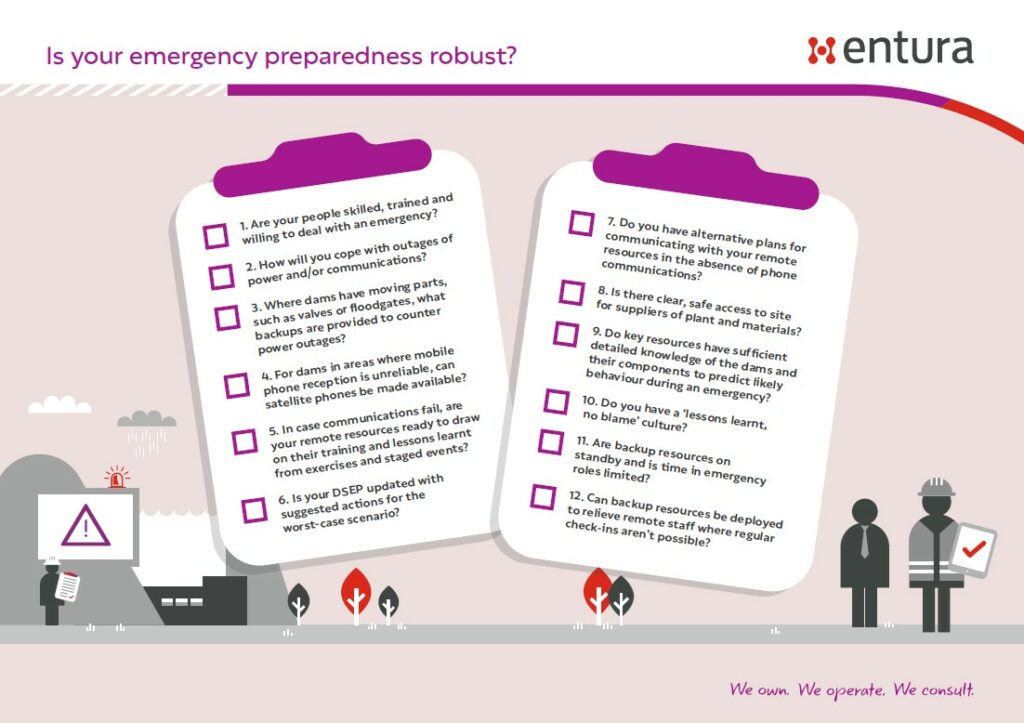
If you would like support with your emergency planning, contact Richard Herweynen or Phillip Ellerton.
About the author
Jamie Cowan is a senior dams engineer at Entura with over 2 decades of civil engineering experience in the UK and Australia. His experience includes the management of investigation, design and construction projects in the civil, dams and water industries. He has worked across all stages of project delivery, from feasibility to the commissioning of assets. He has provided construction support roles during dam construction and upgrade projects, and conducted intermediate and comprehensive inspections of dams for water authorities in Victoria.
MORE THOUGHT LEADERSHIP ARTICLES
Dam Emergency Dewatering Outlets: A ‘Must Have’, or a ‘Nice to Have’?
One contributing factor for dam safety is the ability to rapidly lower the water level in an emergency. But how can dam designers and owners appropriately determine the need for a dewatering outlet or its optimum size in the absence of a consistent international standard?
Dam safety must begin long before the dam is filled
Dam owners are responsible for the continued safety of dams throughout their life cycle, and for maintaining acceptable levels of risk exposure for downstream communities. As we’ve highlighted in previous articles, dam safety can protect lives and drive efficiencies, having a robust approach to dam safety management must be a top priority for dam owners, regardless of the size of the dam.
A dam safety program should be underway before a dam is filled for the first time, especially if there is significant downstream consequences. This dam safety program should include details such as operational instrumentation, regular routine inspections, and personnel and systems in place to make the necessary decisions should any unusual observations occur. The dam safety manager is a key role required to escalate and make decisions in relation to this. In addition, the key dam safety documentation should have been prepared, including a dam safety management plan, dam surveillance plan, dam operation and maintenance plan, dam safety emergency plan, and evacuation plan. We’ve talked about these elements previously in our ten-point plan for safer dams.
Triggers for dewatering
During unusual events such as the first filling of the dam, major floods or major seismic events, the dam needs heightened scrutiny. If visual inspections and instrumentation monitoring indicate any sudden increase in dam deformation, leakage or internal pressures, it is important that an incident is raised and investigated. If the change progresses and may be developing into a dam safety incident, the risk mitigation strategy may be to reduce the reservoir level (i.e. the water loading on the dam).
To rapidly reduce the reservoir level, a low-level, emergency dewatering outlet is usually needed.
The need for an emergency dewatering outlet
It is good practice to provide an emergency drawdown facility in a dam. This enables the reservoir level to be reduced in a dam safety emergency, which lessens the loading on the dam and the volume of water behind the dam.
The purposes of an appropriately sized low-level outlet are (1) evacuation of the reservoir if emergency conditions occur, or inspection, maintenance and repair of the dam and appurtenant works that are normally submerged, and (2) controlling the rate of reservoir rise as required by reservoir filling criteria.
There are examples in Australia and internationally in which no emergency dewatering outlets are incorporated into the dam, or the total outflow capacity provided is inadequate. Yet there is no consistently adopted international standard for the requirement and sizing of an emergency dewatering outlet. This gap in consistent guidance is of concern, given the importance of dewatering outlets for dam safety.
Lack of consistent international standards for dewatering outlets
The International Commission on Large Dams (ICOLD) provides no reference to a specific drawdown rate; however, a number of its technical bulletins do refer to a bottom outlet to empty a reservoir.
ICOLD Bulletin 49a – Operation of Hydraulic Structures of Dams (1986) states: “It is very important for the dam operator to have outlets enabling the reservoir to be drawn down. While bottom outlets do not readily fit into some sites (as with very large reservoirs on very large rivers), there are still many cases where their absence is regrettable or where they are too small or ill designed … Besides allowing the reservoir to be emptied in periods of low river flow, bottom outlets can also provide fine control of the reservoir during the most critical period of a dam’s life, during the first filling, and draw down the level whenever necessary thereafter.”
Some guidance for emergency drawdown was given by the United States Bureau of Reclamation (USBR) in 1990, suggesting drawing down the reservoir volume to either 10% of the storage or 50% of the height in 1 to 4 months.
However, as these guidelines suggest, it may be impractical to provide the drawdown capability to meet the criteria and guidelines for certain projects. Some reservoirs may be just too large for short-term evacuation. The USBR guideline recognises that decisions relating to emergency dewatering outlets should be made considering the risks that the outlet would help to mitigate and the costs to include such an outlet.
Promoting a risk-based framework
A more recent guideline on emergency dewatering outlets for dams is the UK Environmental Agency’s Guide to Drawdown Capacity for Reservoir Safety and Emergency Planning (2017). This document provides guidance on a consistent methodology for assessing the adequacy of existing drawdown capacity at reservoirs in the UK, based on the judgement of an experienced dam engineer. This judgement should consider the proposed basic minimum recommended standards, the consequence of dam failure, the vulnerability of the dam to rapid failure, the time it may take to detect symptoms of failure and to activate drawdown, the time required to draw down the upper third of the reservoir, the ability to keep the reservoir down for repairs, and precedent practices.
The guidelines promote a risk-based assessment, considering options for mitigating those risks. The guidance document states: “The cost of increasing drawdown capacity is compared to the reduction in risk to life achieved, and only implemented where the cost is proportionate”.
These UK guidelines therefore encourage a risk-based framework for evaluating the drawdown capacity of any emergency dewatering outlet. However, the UK has very few very large reservoirs on large catchments, and the guidance provided may therefore not be applicable to very large reservoirs.
What about larger reservoirs?
The challenge in applying the existing international guidance is when the reservoir is very large and/or the dam is located on a very large river. These larger reservoirs are often associated with hydropower projects. This is recognised in the guidance documents discussed above; however, an alternative approach is not provided.
Both the UK and USBR documents do suggest, though, that the reduction in risk created by an emergency dewatering outlet should be weighed against the cost.
Given that an emergency dewatering outlet is not always possible or practical (particularly for large reservoirs), how can risks be mitigated in other ways?
Seven considerations for safer dewatering decisions
When determining whether a dewatering outlet is a ‘nice to have’ or a ‘must have’, systematically consider the alternatives through a risk-based framework and document the decision. With or without an emergency dewatering outlet, it is crucial to develop a robust design, fully consider dam safety, and appropriately mitigate risks to acceptably low levels.
Think about these seven points:
- Consider the inclusion of an emergency dewatering outlet early in planning and design.
It is often easier to incorporate an emergency dewatering outlet into the dam’s general arrangement in the early stages of the design process, rather than later when the dam type has been locked in and all the various components (spillway, intake, diversion) have been located and defined. If it is easy to incorporate, it is good practice to include.
- Consider the risk position without any emergency dewatering outlet.
The main purpose of the emergency dewatering outlet is to be able to take some mitigating action in a dam safety emergency. It is therefore important to determine the risk position of the dam without an emergency dewatering outlet, and evaluate whether this risk is acceptable based on the downstream consequences. Every dam site is unique, so all potential failure modes for this particular dam need to be considered in the risk assessment. If the risk position is not acceptable, alternative options for mitigating the risk should be considered and built into the design and/or operational procedures. Adopt a robust design with sufficient redundancy to mitigate the risks identified through the potential failure modes analysis.
- Understand the potential benefits of an emergency dewatering outlet.
Before deciding that it is too costly to construct an emergency dewatering outlet, at least consider the potential benefits. Gain an understanding, from a holistic project perspective, of the hazards/risks that an emergency dewatering outlet could mitigate. Consider the importance of controlling the rate of initial filling of the reservoir, the ability to evacuate the water from the reservoir at a meaningful rate to make a difference in a dam safety emergency, and the ability and ease of repairing issues below reservoir level by lowering the reservoir rather than undertaking repairs underwater.
- Assess the risk benefit of an emergency dewatering outlet against the cost.
Carefully evaluate the reduction in risk due to the presence of an emergency dewatering outlet compared to the cost – is there a strong justification or not? Even if a full-capacity dewatering outlet is not possible, consider the risk benefit against cost for what is Compare the risk difference ‘value’ with the cost of the emergency dewatering outlet. This will inform a conversation about whether the ‘value’ justifies the cost, which is a strong basis for a sound decision.
- Develop contingency plans for the future.
If there is no emergency dewatering outlet that can enable the reservoir to be emptied for repair works, consider what repair actions may be required during the life of the dam. Ask the questions: What might go wrong? How would we rectify that if we cannot dewater the dam? and Is there anything else that we could build into the design to make this easier? This is ‘safety in design’ thinking, and documenting these high-level contingency plans in the operation and maintenance manual will help those managing the dam in the future.
- Document and communicate the decision.
Document the entire decision process and include the reasons for any decision. All key stakeholders should be aware of and accept the ramifications of any decision. Your organisation should have a robust process in place to assist this decision making process and ensure appropriate consideration in relation to an emergency dewatering outlet. The appropriate dam regulatory body will also need to support and accept the decision.
- Have a robust dam safety program in place.
Any dam with significant consequences downstream (as defined by ANCOLD Guidelines, or similar) should have an appropriate dam safety program in place. If an emergency dewatering outlet is not part of the facility, it is important that the other dam safety risk mitigation strategies identified in point 2 are implemented. The dam safety emergency plan should clearly state the actions to be undertaken in a dam safety emergency, as well as who is responsible for them.
A dam safety emergency dewatering outlet can enable a dam owner to be proactive in a dam safety emergency, and help to maintain or reduce the dam safety risk. As such, it is always a nice thing to have as part of a dam facility, and it should, ideally, be included in any new dam. However, if it is not possible or practical to include a dewatering outlet, be sure to make careful, considered decisions based on a comprehensive understanding of risks and consequences.
If you’d like to discuss how we can assist you with planning, designing and constructing safer dams, please contact Richard Herweynen, Paul Southcott or Phillip Ellerton.
About the author
Richard Herweynen is Entura’s Technical Director, Water. Richard has three decades of experience in dam and hydropower engineering, and has worked throughout the Indo-Pacific region on both dam and hydropower projects, covering all aspects including investigations, feasibility studies, detailed design, construction liaison, operation and maintenance and risk assessment for both new and existing projects. Richard has been part of a number of recent expert review panels for major water projects. He participated in the ANCOLD working group for concrete gravity dams and is the Chairman of the ICOLD technical committee on engineering activities in the planning process for water resources projects. Richard has won many engineering excellence and innovation awards (including Engineers Australia’s Professional Engineer of the Year 2012 – Tasmanian Division), and has published more than 30 technical papers on dam engineering.
MORE THOUGHT LEADERSHIP ARTICLES
What levels of flood protection and downstream risk are acceptable for cofferdams?
In previous thought leadership articles, we’ve argued that the downstream consequence of dam failure is a better measure of dam risk than the size of the dam. For example, saddle dams can often have significant consequences downstream, despite being smaller than the main dam. The same applies to cofferdams.
A cofferdam is a temporary dam that diverts a river during construction of the permanent dam. The cofferdam enables the main dam site to be dewatered and protected throughout construction. The river flows are diverted around the site through a diversion channel, conduit or tunnel, which has a certain flood capacity beyond which the cofferdam would overtop. Overtopping of the cofferdam could lead to failure of this temporary dam, and the ramifications of such an event depend on the volume of stored water behind the cofferdam and the consequences downstream.
There is greater scope to accept more risk in the design and construction of the cofferdam if the construction period is short, the cofferdam is relatively small and the downstream consequences are minimal. But if the cofferdam is a high structure with significant consequences downstream, what level of flood protection is acceptable?
This issue is common when constructing a dam on a large river. Despite the cofferdam usually being significantly smaller than the main dam, and although the risk exposure period is only the duration of the construction of the permanent dam, we must consider the life safety risk to the downstream community. If the downstream consequence is great, appropriate dam engineering principles and standards need to be applied to the design and construction of these temporary cofferdams to protect the downstream community from unacceptable risk during the construction of the main dam.
There is no consistent, appropriate international practice or standard for risks associated with handling flood during construction, be it for river diversion during construction of a new dam, or flood management during remedial works for an existing dam. The overall perception of dam engineers has been that higher risk levels are acceptable during short-term construction periods, compared with the long-term risks for the completed structure.
Traditionally, the flood capacity associated with the cofferdam and diversion works was based around the construction flood risk and became a cost optimisation problem, taking into account the lost time and damages that would be caused by overtopping. However, if there is a population downstream, we are talking about the downstream risk to life, which is no longer simply a financial issue.
The outdated Australian National Committee on Large Dams (ANCOLD) Guidelines on Design Floods for Dams 1986 proposed that the river diversion flood risk during the relatively short construction period of a cofferdam should be an equivalent order of safety to the recommended design flood relevant to the consequence over the life of the permanent dam. For a high-consequence-category dam with a construction period of 5 years, the guidelines recommended a 1-in-500-year river diversion flood capacity.
This is similar to the Brazilian guidelines given in the International Committee on Large Dams (ICOLD) Bulletin 170 – Flood Evaluation and Dam Safety (2018), where for each management stage of the river during construction, the flood capacity for the diversion works should be defined based on the risk of flooding downstream, taking into account the exposure time. The following table is based on the Brazilian guidelines, taking into account the risk to human lives downstream. If there is real danger of loss of human lives and there would be major damage to the works and their progress, then the annual risk of damage to the cofferdam should be less than 1%.
| Category | Annual risk of damage |
| No danger to human lives No provision for serious damage occurring to the work or its progress |
5% to 20% |
| No danger to human lives Some provision for significant damage to the work or its progress |
2% to 5% |
| Some danger to human lives Provision for significant damage to the work and its progress |
1% to 2% |
|
Real danger of loss of human lives Provision for major damage to the work and its progress |
<1% |
According to the ‘Diversion of Large Brazilian Rivers’ document prepared by the Brazilian Committee on Dams for the 2009 ICOLD Congress in Brasilia, the maximum river diversion flood capacity provided for major dam projects in Brazil was the 1-in-500-year flood. This is currently considered to be the internationally accepted standard for temporary cofferdams, but is it acceptable from the perspective of risk to life for downstream populations?
Owners need to consider the degree to which the risks imposed on the population by the dam during construction are acceptable and defensible. The current ANCOLD Guidelines on Selection of Acceptable Flood Capacity for Dams (2000) indicates that there is no consensus or risk standard that specifically considers whether risk-to-life criteria that relate to the overall risk over the long life of a dam are equally applicable to the short-term construction period. Compliance with various risk-to-life criteria would generally result in very conservative construction flood provisions compared with historical practice, and therefore should only be used to assist when considering and deciding on construction flood options. Although it may have been traditional to accept higher risks during construction than those acceptable for the completed dam in service, it is unlikely that such practice would be defensible in the event of a failure resulting in loss of life.
When deciding on the diversion flood capacity for the cofferdam arrangement, consider these elements:
- Consider the downstream consequences of an upstream cofferdam failure. This is particularly important if there is a downstream population that would be at risk. To quantify the impact of dam failure, dambreak assessment may be needed for the upstream cofferdam.
- Adopt an engineering standard for the cofferdam that reflects the risk. The higher the consequences downstream, the more stringent the design standards should be for the cofferdam, including the flood capacity of the diversion works. The design should consider the potential failure modes of the cofferdam (e.g. flood overtopping, internal erosion, etc.), and appropriate design measures should be adopted so that the chance of failure is appropriately low.
- Explore ways to mitigate the risk to the downstream community by:
- giving preference to lower cofferdam options with larger diversion flood capacity
- staging the flood protection works to minimise exposure time
- including emergency spillways or fuse plugs as part of the cofferdam design to control any downstream flooding
- preparing for major flooding events (as discussed below).
- Ensure that the cofferdam is constructed in accordance with the design and with a high level of quality assurance, especially if the cofferdam is demonstrated to be a high-consequence-category dam. The quality control (QC) and quality assurance (QA) processes on site must reflect the downstream consequences and risk to life. The higher the risk, the higher the justification for investing in appropriate QA/QC for the cofferdam construction.
- Have a dam safety emergency plan (DSEP) in place during construction. If downstream populations are at risk, it would be appropriate to have a DSEP for the cofferdam during construction of the permanent dam, along with appropriate monitoring of the cofferdam. Having a DSEP in place during construction is good practice for any high-consequence dam. By monitoring the dam, it is possible to identify early whether a dam safety emergency is developing. Early identification allows appropriate action to be taken as soon as possible, through intervention or early warning. This will help to mitigate the residual risk for the downstream population, and enable the contractor to intervene at the construction site. It will also provide clear lines of communication and understanding of responsibilities, should any potential dam safety emergency occur.
- Develop and implement good flood forecasting and warning systems. If a contractor has enough warning before the flood occurs, they can act to mitigate potential impacts. For example, construction workers and equipment can be removed from the area between the upstream and downstream cofferdams. Adequate warning time will dramatically increase the chance of survival should the dam fail. With appropriate rainfall stations and streamflow stations, flood prediction and flood warning models can be developed to provide increased foresight before a large flood event, so that there is more time to take pre-emptive action and inform any downstream communities.
No matter the size or the impermanence of a dam structure, always consider the downstream consequences. Even though a cofferdam is a temporary structure, it is still a dam, and its failure could lead to significant downstream consequences including risks to life. And that’s why we should consider applying the same dam safety practices to cofferdams as we do for permanent dams. In the end, it’s all about identifying and managing the risks and protecting what’s vulnerable downstream.
Find out what prompted Richard to write this piece below.
Entura has been involved in the decision-making process for many cofferdams associated with the construction of large dams on large rivers. If you’d like to discuss how we can assist you with planning, designing and constructing safer dams, please contact Richard Herweynen, Paul Southcott or Phillip Ellerton.
About the author
Richard Herweynen is Entura’s Technical Director, Water. Richard has three decades of experience in dam and hydropower engineering, and has worked throughout the Indo-Pacific region on both dam and hydropower projects, covering all aspects including investigations, feasibility studies, detailed design, construction liaison, operation and maintenance and risk assessment for both new and existing projects. Richard has been part of a number of recent expert review panels for major water projects. He participated in the ANCOLD working group for concrete gravity dams and is the Chairman of the ICOLD technical committee on engineering activities in the planning process for water resources projects. Richard has won many engineering excellence and innovation awards (including Engineers Australia’s Professional Engineer of the Year 2012 – Tasmanian Division), and has published more than 30 technical papers on dam engineering.
MORE THOUGHT LEADERSHIP ARTICLES
Make better decisions about hydropower and dam project options using risk-based multi-criteria assessment
How can owners or developers assess alternative options for hydropower and dam projects objectively and consistently? How can you maintain an appropriate balance among the environmental, social, financial and technical risks? If you place a value on the non-cost aspects of projects, how can you confidently assess the many criteria that your project options bring into play?
Traditional methods aren’t always best
The traditional approach to evaluating a range of alternative project arrangements and selecting a preferred option would be to apply a numerical ranking and weighting to a range of criteria to reach a weighted score for each project option (as shown in the table below). The recommended project arrangement would generally be the one with the highest weighted score. However, there are some major downsides to this methodology.
One problem with the traditional method is that the guideline for scoring can be fairly arbitrary (e.g. 1 = poor, 10 = excellent or 1 = high cost, 10 = low cost). Furthermore, scoring can be subjective and can vary from assessor to assessor. A project with strong scores in some areas may still achieve the highest weighted score even if it has low scores in other areas – and this can be accentuated by varying the weighting of individual criteria to contribute less to the overall score. Individual low scores can be very important as they could be show-stoppers. The averaging approach can therefore be misleading. The lack of transparency of this traditional approach can make it difficult to explain the results to internal and external stakeholders.
An alternative approach is a risk-based method.
A risk-based approach to multi-criteria analysis brings benefits
Compared with the traditional method, a risk-based approach may lead to a less subjective and more defensible assessment, as a consistent set of criteria is applied across all projects and/or arrangements. High risks remain very visible because there is no weighting or averaging. This process can be easily explained to internal and external stakeholders.
A risk-based approach uses a risk rating table, similar to that shown below, which can be used to rate the risks of many different types of hazards. This approach is familiar to many because it is used extensively throughout industry in many applications including, for example, safety management.
The standard risk assessment process is followed, which involves identifying the hazards, assessing the likelihood and consequence and therefore risk, identifying mitigation measures and re-evaluating.
Define the likelihood and consequences of risks
To undertake a multi-criteria assessment using a risk-based framework, you first need to develop a set of definitions for consequence and likelihood. The definitions should relate to a set of criteria, for example a hydropower project may consider natural environment, social and cultural heritage, reputation and client relationships, planning and approvals, and project delivery. For each criterion, define the consequence, ranging from a ‘Low’ through to a ‘Catastrophic’ outcome.
Developing these consequence definitions can be complex and require endorsement from within the owner’s or developer’s organisation. Many organisations already have a set of relevant consequence definitions as part of their corporate risk management processes. In some cases, these definitions may need amending (e.g. to accommodate a larger project); however, this could potentially be easier and more efficient than starting from scratch.
Developing a likelihood table is relatively straightforward. It simply requires a probability range to be associated with each likelihood definition, for example ‘Almost certain’ = 90–100%. The likelihood table can then be applied in subsequent risk assessments.
Once the consequence and likelihood definitions are agreed, you’re ready to undertake the multi-criteria assessment using a risk-based framework.
Nine steps towards a robust multi-criteria options assessment
Depending on the project, a multi-criteria assessment will often involve considering the cost, schedule and risk of each option.
The following checklist sets out a nine-step method to guide a risk-based multi-criteria assessment of alternative options for a hydropower, pumped hydro energy storage or dam project.
The steps set out above can be repeated to review other project options.
Ultimately, a degree of subjective evaluation may be needed, but this methodology will certainly support you to consider multiple criteria in your decision-making process, and is likely to highlight any major risks that may be considered to be show-stoppers. Using a risk-based approach and following the methodology above will set you on a solid path towards a consistent and defensible approach for your options assessment.
If you would like to discuss how Entura can assist with assessing your project options and their associated risks, including multi-criteria assessment of your hydropower, pumped hydro energy storage or dam project, please contact Phillip Ellerton on +61 439 010 172, Tim Griggs on +61 409 365 329 or Richard Herweynen on +61 429 705 127.
About the author
Tim Griggs is a specialist civil engineer with the hydropower and pumped hydro energy storage team at Entura. He has over 25 years of experience in the fields of civil engineering, dams and hydropower including feasibility studies, design and construction support, and has worked on projects located in Australia and the Indo-Pacific region. He is currently the hydropower design leader for Hydro Tasmania’s Battery of the Nation project that is undertaking feasibility studies into the development of a large pumped hydro energy storage project in Tasmania.
MORE THOUGHT LEADERSHIP ARTICLES
Multipurpose dams: maximum value for money?
When a dam is being considered, there’s usually a primary purpose. But are there also secondary purposes that can benefit the local and wider community? Have you thought about the potential additional economic development that can stem from a multipurpose dam?
Multipurpose dams combine two or more functions of traditional single-purpose dams into one dam infrastructure project. A multipurpose dam may combine storing and supplying water for irrigation, industry or human consumption; flood control; power generation and power storage; navigation; water regulation; environmental releases; climate change resilience; and recreational purposes.
The dam structure will be similar to a single-purpose dam, but the design will incorporate features into the dam and water infrastructure facility to accommodate different purposes. These may take the form of irrigation channels, power generation facilities or navigation facilities. Including various gates or valves can provide greater operational flexibility for floods or environmental releases for downstream community and environmental needs. A single-purpose project can become multipurpose during its planning stage, during operation, or in the long term when re-engineering becomes necessary.
Why consider multiple purposes?
Multipurpose dams are not a new concept; in fact, almost half of all dams are used for more than one purpose. There is a growing trend to consider multiple purposes when developing a dam, for several reasons:
- Dam sites, particularly storage sites, are scarce national resources (i.e. they are not unlimited), so it makes sense to consider how to extract maximum benefit from them when constructed.
- Dam infrastructure may commonly last for up to 100 years or more (i.e. they are considered a long-term asset). A dam represents a genuine long-term investment for the future, and so ideally should be viewed as such and incorporate the potential for flexible use over time.
- Multipurpose dams are very beneficial in developing countries, as the multi-functionality of the dam operations can contribute to a number of development goals simultaneously, such as energy, water and food security, economic development, and climate resilience. In 2016, the International Commission of Large Dams (ICOLD) recognised the importance of multipurpose dams in the release of the ICOLD Bulletin ‘Multipurpose Water Storage – Essential Elements and Emerging Trends’, which rightly links the common global needs of water, food and energy. The sporadic, spatial and temporal distribution of precipitation rarely coincides with demand, making storage essential for food supply, energy production, potable water supply and other water delivery services that depend on sizable, reliable, continuous and efficient supply of water.
- Climate change scenarios predict increasing variability in rainfall, impacting both yields and flood peaks. Droughts will affect agricultural production, and flooding is expected to increase due to more extreme weather events. With many regions of the world experiencing significant water stress, which is expected to be exacerbated by global warming, storage will play an increasingly critical role in bolstering a water system’s hydrological resilience. Dam projects should be designed with this necessity and value of storage in mind. Even in developed countries, we need our dam infrastructure to be ready to adapt to future changes as required. Taking change into account and considering multipurpose approaches will benefit new dam projects as well as projects that modify existing reservoirs.
Looking into the future
Multipurpose water storage projects pose additional engineering challenges when compared to single-purpose projects. Given the longevity of the infrastructure of large storage projects, planning professionals need to develop and implement solutions that will provide adequate flexibility to adapt to changes or to the diverse needs of multipurpose schemes. Scale, site selection and operational characteristics should be assessed through a long-term perspective, incorporating anticipated trends and emphasising adaptability so that future generations will inherit infrastructure that can evolve as the world continues to change.
There is no doubt that this sustainability principle is valid; however, determining how best to implement it in practice is not always easy. It is hard to anticipate and predict what will happen in a century (which is the expected life of many dams), yet this should not stop us during the early stages of the project from trying to assess long-term performance based on potential long-term scenarios (i.e. scenario testing).
Multiple perspectives for multiple purposes
Achieving the best outcome for a multipurpose dam is more likely when planners and engineers work together and closely consider the local community’s needs and the potential benefits to be gained. Both social and environmental needs should be considered, with detailed social and environmental impact assessments conducted.
Applying the principles of Integrated Water Resource Management (IWRM) in the planning process will help promote coordinated development and optimal management of water resources – furthering progress towards goals of social equity, economic efficiency and environmental sustainability. It is important to establish criteria by which to monitor the achievement of the multipurpose objectives and the post-construction impacts on the community and environment. Another important consideration is the manner of operation of the multipurpose reservoir, which will also be critical to achieving the range of its objectives.
What is a multipurpose dam worth?
A key planning challenge in multipurpose dam infrastructure is fully appraising the economic costs and benefits of the project. In many projects there’s a tendency to focus the analysis on the components that provide revenue streams (such as energy and water supply and irrigation tariffs) as these are most easily valued. However, this can underrepresent the project’s value across all of its multipurpose objectives, potentially resulting in suboptimal decision making or difficulty justifying the long-term investment. For example, a fundamental purpose of storage projects is flood mitigation – but flood mitigation does not generate a revenue stream. However, the economic value of flood control to a country (through avoidance of direct and indirect flood damages) often justifies the allocation of funds from the public sector.
Putting this into practice in Samoa
The Alaoa Multi-Purpose Dam in Samoa is a fitting example of the considerations presented above.
Samoa is a small tropical island country in the Pacific, and has been heavily affected by severe tropical storms. In 2012, Cyclone Evan caused extensive flooding and damage to the Apia region, the capital, where most of the population and economic activity is located. With such storms predicted to increase in frequency and severity as the climate changes, the Government of Samoa has adopted a programmatic approach to address climate-change-induced flooding. This includes the new Alaoa Multi-Purpose Dam, sized and designed with long-term climate scenarios in mind and to provide multiple functions. It aims to increase flood protection, improve the current water supply system’s seasonal reliability, and provide additional hydropower via installation of a small hydro facility.
The dam’s design considered multipurpose functions and climate change risks, and included small modifications to provide better outcomes. Climate resilience was ‘designed in’ by incorporating ‘dead storage’, providing sediment flushing capability, increasing the flood capacity, and including a number of gates and valves – all contributing to future flexibility of operation.
The intake to the small hydro station incorporated a station bypass valve for water supply. As well, a low-level outlet and a mid-level outlet were added to increase the operational flexibility of the dam to meet its three purposes. This also enabled both low-flow and high-flow environmental releases, and improved dam safety management. How the reservoir is operated will be significant in achieving the multipurpose functions. The dam’s flexibility will allow future adaptive modification of the operation to align with the changing demands of the reservoir.
The main purpose of the Alaoa Multi-Purpose Dam was flood retention and mitigation. Consequently, as we discussed above, a limited financial analysis could not justify the multipurpose project, yet the broader economic analysis could. However, the financial analysis indicated that the regular revenue stream from the small hydro’s energy production could increase the project’s sustainability once constructed. This revenue stream would contribute to the ongoing operation, maintenance and dam safety activities associated with the multipurpose project’s long-term operation.
Could multiple purposes be incorporated into your dam project?
Whether you are in the planning process or the early design phase for a new dam, consider whether your project could be modified to:
- achieve multiple purposes and increase the benefits of your dam project
- increase operational flexibility to allow your dam to adapt to future changes and demands
- improve the use of water resources for all needs, including the environment
- increase the climate resilience of your dam and the impact of climate change on its multiple objectives.
If you would like to discuss how we can assist you with planning and designing a multipurpose dam, please contact Richard Herweynen, Paul Southcott or Phillip Ellerton.
About the author
Richard Herweynen is Entura’s Technical Director, Water. Richard has three decades of experience in dam and hydropower engineering, and has worked throughout the Indo-Pacific region on both dam and hydropower projects, covering all aspects including investigations, feasibility studies, detailed design, construction liaison, operation and maintenance and risk assessment for both new and existing projects. Richard has been part of a number of recent expert review panels for major water projects. He participated in the ANCOLD working group for concrete gravity dams and is the Chairman of the ICOLD technical committee on engineering activities in the planning process for water resources projects. Richard has won many engineering excellence and innovation awards (including Engineers Australia’s Professional Engineer of the Year 2012 – Tasmanian Division), and has published more than 30 technical papers on dam engineering.
MORE THOUGHT LEADERSHIP ARTICLES
Keeping international projects moving, even when we’re grounded
With no set date for when life will return to usual after COVID-19, nor any guarantee of whether life will ever return to what we previously knew as ‘usual’ at all, there are very few areas in the consulting life in which we can simply say ‘we’ll wait until this is all over’. Life, and projects, must go on.
Although we can’t avoid the disruption and uncertainty that the coronavirus has unleashed, we can increase our resilience and agility. We can also embrace opportunities to innovate and to create new ways (or reinvigorate old ways) to achieve our goals.
Here, Entura’s Environment and Planning team continue to apply their proactive approach to keeping projects alive in the current circumstances, and explain how they are continuing their activities on two international projects despite the travel restrictions that are making it impossible to visit the project sites.
Old ways for new times – Engaging communities in Tonga
For many countries across the globe, the immediate challenge is building resilience to fight through the pandemic. However, for some small island nations that have managed to stay out of the virus’s path so far, such as Tonga and the Federated States of Micronesia, the concept of resilience has a broader context.
Climate resilience is a core objective, as these nations are feeling the increasing impacts of rising sea levels and more frequent and intense weather events. In this context, robust power infrastructure that is suited to extreme weather is one component of greater resilience, as is transitioning from diesel dependence to higher levels of renewables, which builds greater security of energy supply at a lower longer term financial and environmental cost. More access to stable, reliable and clean electricity is also critical for the health, wellbeing and education of local communities, and is the foundation for economic development. Entura has been fortunate to be involved in some meaningful resilience-building projects in the Pacific, supporting many of our neighbouring nations to implement sustainable energy solutions.
However, with a current project in Tonga, coronavirus has thrown our travel plans into disarray. The challenge we’re facing now is how to continue the planning, engagement and environmental activities required by such a project when we can’t physically get there, can’t hold town hall meetings and can’t host information sessions with locals.
While the pandemic is forcing many practitioners to extend and expand their use of digital forms of engagement (such as websites, Facebook, Twitter, ‘Bang the Table’ or moderated ZOOM-based focus groups), some projects are located in communities that do not enjoy easily available or reliable internet or telephone access. In these cases, such as our project in Tonga, we need to think differently about ways to facilitate engagement from a distance.
For the Tongan project, we’re heading back to basics: the tried and tested solution of providing information on paper. Working with the local project management unit, along with our client, we are designing and implementing a newsletter to be printed in the local language and distributed to regulators and communities. It will provide snapshots of the project, latest updates on scheduling, and will even feature some interviews to provide greater coverage of ongoing community engagement.
As the construction company for the project is, like us, unable to travel internationally at the moment, construction is yet to take place. Nevertheless, we are continuing to facilitate all aspects of the project remotely, such as lining up approvals with regulators, and guiding engagement on the ground. With the help of our Tongan counterparts, we can still keep information and updates flowing despite the physical limitations on our involvement ‘in the flesh’.
Buying time and building partnerships in South-East Asia
Just as COVID-19 started closing borders and halting international travel, our team was reaching the culmination of many weeks planning an impact assessment for a large infrastructure project in South-East Asia. Our discipline experts were about to book their tickets and embark on the journey to site to survey environmental and social impacts. However, we placed the site surveys on hold indefinitely to comply with travel restrictions, ensure the safety of our people and contractors, and not risk spreading the virus in remote communities.
This abrupt shift in our plans afforded us the chance to take a breath, reflect on the project and its broader risks, and then develop an alternative plan to keep progressing aspects of the work that could be done remotely. We are now proactively undertaking desktop approval studies and initial public consultation from our desks. We’re ‘buying time’ now to save time later.
When travel restrictions lift and it is once again safe to physically attend the site, we will be ahead of where we would have been pre-COVID-19. We will better understand potential issues and have a more thorough insight into the local and community context. We’ll have already carefully planned our field studies with more targeted approaches. We’ll be better prepared for stakeholder questions that may arise, and will have already considered ways in which the project might manage challenges and risks going forward.
But there’s something more that we’re seeing emerge in this COVID-19 period. We’re finding that the shared need to adapt to trying times and the mutual desire to find workable solutions is strengthening our relationships with our clients, building even greater trust and collaboration, and it is leading to ‘partnership’ relationships that transcend the more common transactional paradigm of client–consultant. We are working closely together to openly discuss issues and options, and to determine how best to manage emerging challenges to benefit the project.
Would this have happened without COVID-19? Perhaps – but under the usual pressure of timelines, expectations, standardised processes and the drive for efficiency, there isn’t often the same flexibility or space to build different qualities and layers in our relationships or to consider potential issues quite so broadly or creatively.
Will the project benefit from the changes made necessary by COVID-19? Probably – despite the difficulties caused by the limitations on travel, it can only be positive to have had the chance to take the time to more thoroughly and holistically consider all the issues and risks before we proceed to field studies and stakeholder engagement.
Will timelines change significantly because of COVID-19? Not necessarily – we will inevitably lose some months by not being able to go into the field, but we will have ‘bought’ some time by compiling a good portion of the project documentation prior to the field studies, so that the time required in subsequent stages is lessened.
Wherever in the Indo-Pacific region our international projects are located, our clients can be confident that we’re seeking all the ways we can – new or old – to keep making progress in these uncertain and complicated times … and to come through them stronger together.
If you would like to discuss how Entura can help you with your environmental or planning project, please contact us.
Don’t let COVID-19 stop your project
A vital part of the success of all projects, whether they are new or operational, is maintaining progress towards milestones and retaining currency in the social and regulatory realms. How can we achieve this during a global pandemic?
With the COVID-19 crisis affecting people and businesses across the globe, employers and employees alike are racing to find normalcy. Fortunately for Entura, we’ve already been working and collaborating virtually for many years across country and state borders, with dispersed office, client and project locations. So, even though our teams are working from home, it is still business as (mostly) usual, in unusual times!
Although COVID-19 hasn’t thrown us completely, travel restrictions have pushed us to think differently about many of our projects and methods. This is the time to explore proactive ways to ensure projects do not come to a grinding halt or fall off a community’s or regulator’s radar.
Keeping environmental and planning projects moving forward
Entura’s environment and planning team works frequently in the field – lakes, forests, roadsides, development sites and many more – so COVID-19 travel restriction have taken a hit at our ability to undertake survey and monitoring programs or to conduct site visits, but it hasn’t led to tools down.
We may miss out on our chance to hit the frosty outdoors this autumn and winter, but there are still many ways that we can and will continue to make progress and deliver value. It’s about thinking creatively about how we can be proactive. And that means finding measures and activities for the short and medium term that will keep the project moving towards the longer term project milestones and goals (without the anticipated longer term extending into the much further horizon!)
For example, there are proactive things we can do to prepare us better for when we can once again visit the site. We have access to a wide range of data and can undertake thorough desktop investigations early in the project. We will then be able to step on site well prepared and looking to fill knowledge gaps or to verify what should be there. That puts us in a better position to be alert to anything unexpected we might find when we’re physically on site in future. Unusual discoveries and observations will be more pronounced. Such approaches can help shorten project timelines post-COVID-19 compared with the inevitable blowouts that would be caused by downing tools completely.
Policy and regulatory reforms are also still happening across the country – some as a result of COVID-19, others associated with larger reform programs to update antiquated legislation. Our discipline experts continue to engage with the regulators and relevant government agencies and authorities to ensure we understand the nuances of these changes and how they may influence the scope of existing and future projects and programs of work.
More proactive, less reactive
The restrictions caused by COVID-19 have highlighted the need to be proactive so that we can be better positioned for the longer term. It’s natural for a consulting paradigm to tend towards the reactive and process-driven, but this is the time to shift such tendencies.
With a future-focus and forward thinking, we can all seek out proactive solutions to keep projects and processes running as smoothly as possible, to meet any milestones that are still feasible, and to do everything that is reasonably possible in the present circumstances that will minimise delays once the pandemic has eased.
This needs to be a shared process. If as consultants and clients we put our heads together, we can develop shared understandings of the opportunities, risks and issues affecting all parts of the project and all the players involved. With team work and good communication, together we’ll find the most innovative and workable solutions, and together we will survive and thrive.
Beyond the immediate
The circumstances of the pandemic are also an opportunity to think beyond the immediate projects on our desks. This is a great time for our clients to review their projects and environmental and social management practices, to be better positioned for the post-COVID-19 future. This could include being more informed about potential risks or thinking through changes that you could make to your management practices to better address ongoing or emerging issues.
In our next article, we will highlight some of the projects we are currently working on, and how we have adapted them in light of COVID-19. We will also dig down into some of the key regulatory reforms happening across the country, and what implications they may have on projects during the COVID-19 period and beyond.
At Entura, we will continue to respond to government measures as they surface, and we will continue to be here to assist all our clients to better understand the opportunities, risks and issues associated with keeping your project alive during COVID-19.
A message from our team to yours
And to finish on a light note – Entura’s environment and planning team has nimbly settled into their new branch offices, from urban Melbournian set-ups to peri-urban workplaces at the foothills of the majestic kunanyi/Mount Wellington in Tasmania. From our team to you or yours, here are a few handy tips which we have found to help with this transition to working from home:
- Stay connected – drop your colleague or manager a line and ask how they are going, and where possible (bandwidth permitting), turn on the video during your virtual meetings.
- Schedule regular team catch-ups, and why not end the week with an optional virtual gathering to kickstart some weekend banter?
- Don’t be embarrassed if your pets or children make an appearance – it helps lighten the mood and may provide the laugh that someone really needed.
- Get some fresh air before you start work – imitate that commute to work by going for a walk or cycle.
If you would like to discuss how Entura can help you with your environmental or planning project, please contact us.
Pictured, clockwise from top left:
- Senior Social and Stakeholder Consultant, Dr John Cook
- Land Use Planner, Bunfu Yu
- Senior Aquatic Scientist, Dr Malcolm McCausland (and friends)
- Team Leader Environment and Planning, Raymond Brereton
- Senior Environmental Planner, Cameron Amos
- Senior Planning and Environmental Consultant, Scott Rowell (about to head out for a ride)
- Environmental Consultant, Rachael Wheeler
MORE THOUGHT LEADERSHIP ARTICLES
Engineering – by humans, for humans
When engineers think about the future, do we get so engrossed in the complex technical problems that we don’t attend enough to the human angle?
Engineers have a reputation, whether rightly or wrongly, for being poor communicators, working obsessively and in isolation, and focusing on the immediate goal rather than its impacts on communities. Often, clichés have a basis in truth. If we are going to shift perceptions, we need to start by thinking about the way we work and the leadership we show to the next generation of engineers.
There’s no way we can predict the major developments, challenges or solutions of the next five or six generations of engineering careers. What we should focus on is what we can do right now to lead change in our profession and our communities – and I think the keys are communication, collaboration and community.
Communication
I recently listened to a podcast in which two energy market experts talked with a power system engineer. They discussed all sorts of technical matters relating to frequency and voltage control. I love those topics, but this conversation was limited and uninspiring because the participants simply didn’t have a common language or understanding.
We need to learn to communicate in ways that a variety of people can understand. That will mean better conversations with the people who can help our work have greater impact, and it will help our communities to appreciate the importance of our work in their lives.
It’s too easy for us as a profession to sit at our desks or stand under our hard hats and luxuriate in how clever we are, and then bemoan how so many people have no idea what we do and don’t value our work.
When things that involve engineers go wrong, a flurry of opinions erupts. Failures such as the blackout in South Australia, or the cladding issues at the Grenfell Towers, or issues with airlines or bridges or dams all lead to our communities questioning and debating engineering practice. Engineers tend to try to stay out of this rough and tumble for fear of being misrepresented. Yet maybe it’s better that we do engage where we can, since being misrepresented on a small issue is better than allowing a groundswell of misguided public opinion due to a lack of understanding of engineering principles.
We need to try to better explain our work and find simple ways to convey the complexities of the decisions that we make.
Collaboration
The world is far more complex now than it was a century ago – but it is impossible to imagine what level and pace of change future generations will experience. If we want to transform our world or help build a better future, we can’t do it by ourselves.
Engineering no longer operates in isolation, if it ever did. We must collaborate across the engineering team and across other professional disciplines to achieve truly effective development for our communities. Sometimes we may need to focus a little less on technical delivery as a primary outcome, and increase our recognition of the value gained by engaging successfully with the communities on whom the project relies for success.
Collaboration makes our work more effective, and exposes us to a wider range of inputs and values that we can incorporate into our designs and processes. Engineering can be a leader but it can also be a facilitator for better outcomes when we draw on, listen to and learn from the other experts involved in other aspects of our projects.
Community
Engineering work almost always benefits more people than merely the one who pays the bill. Much of my work is in connecting wind farms and solar farms to the grid. Mostly my work is paid for by the owner of the farm, and while it delivers direct benefits to the owner through return on investment, it also affects everyone connected to the nearby network. It affects the network service provider and market operator, it pays salaries, and it supplies the clean energy that helps the country reduce emissions and meet its international targets. In other words, my work, which may seem intangible, has tangible effects in the real world.
If we agree that our labours produce real impacts, we need to take better care to fully consider the wider consequences of our work, which often has the potential to cause ‘collateral damage’. We can’t build a road or a wind farm without changing the landscape. When we build a machine, it uses energy and may emit pollutants; and it reduces reliance on manual labour, which may put someone out of a job. There may be a risk to lives, livelihoods or the environment if something goes wrong.
Do we always make decisions about these matters with the community front of mind, or do we place our clients on the higher pedestal? This is a tricky area and I’m not espousing a puritanical approach. However, if we knew in 1919 what we know now about lead poisoning, acid rain, greenhouse gases, scarcity and general sustainability principles, what different choices could have been made?
In a time of automation, we need to think about benefits and risks and how they affect our communities. On one occasion early in my career, I designed a controller to turn on and off a couple of compressors at a power station. I wrote some code to balance the run hours. A few months after the new system was commissioned, I asked one of the operators how the system was going, in terms of the run hours management, and he said ‘you’ve done me out of a job’. I hope he was joking. The task he’d been doing wasn’t particularly important, but there was value in having a person who was in tune with the equipment to take care of it, and there was also value in giving that person dignity through work.
My point is that we must keep our communities foremost in our minds as we go about our work. It’s not just about what we produce. It is the way we work and the people we choose to work with and for. Our influence on the development of the next generation of engineers perhaps has more impact on communities than our actual work outputs.
Through communication, collaboration and community, engineering can be both ‘more human’ and ‘for humans’.
About the author
Donald Vaughan is Entura’s Technical Director, Power. He has more than 25 years of experience providing advice on regulatory and technical requirements for generators, substations and transmission systems. Donald specialises in the performance of power systems. His experience with generating units, governors and excitation systems provides a helpful perspective on how the physical electrical network behaves and how it can support the transition to a high renewables environment.
MORE THOUGHT LEADERSHIP ARTICLES
Safer dams are a matter of priority
Examples from around the world demonstrate the devastating consequences of dam failures. Safety must be every dam owner’s key concern, but how should action be prioritised across a large portfolio of dams?
To prioritise effort and resources to achieve the best safety result across a whole portfolio of dams, you need a portfolio risk assessment (PRA). A PRA determines the risk position of the dams based on known information, identifies any information gaps, develops a strategy to close these gaps, and then determines the most effective actions to decrease any risks.
APPLYING PRA TO A LARGE AND COMPLEX PORTFOLIO
Entura has supported dam owners and water managers across the Indo-Pacific region with PRAs, but our most extensive application of the PRA process has involved the 54 large dams of our parent company, Hydro Tasmania.
Hydro Tasmania is Australia’s largest water manager and is committed to ensuring that the risk of a dam failure is very, very low across the entire portfolio. Across so many dams, clear priorities are needed to focus dam safety efforts and human and financial resources.
It has now been 20 years since Hydro Tasmania’s PRA journey began in 1999, so it’s timely to reflect on its outcomes.
With so many dams of greatly varying types, ages and heights, the PRA across Hydro Tasmania’s dams was always going to be complex, and needed to be staged. The first step was a small pilot study on five selected dams that represented the range of potential risks within the broader portfolio.
During the pilot study, the five steps of Entura’s PRA process were defined:

This methodology was applied across Hydro Tasmania’s dams portfolio, and an average of eight dams were added to the review each year.
By 2005, the initial ‘baseline’ assessment of the full portfolio was complete. The focus of the dam safety program has now moved to investigation and implementation of upgrades, and the communication of outcomes to senior management.
The PRA process has increased the focus on potential failure modes and risk as drivers of the dam safety program and as the basis for deciding priorities for allocating operational and capital resources.
DETERMINING PRIORITIES THROUGH A RISK FRAMEWORK
Entura’s PRA process reviews the consequences of failure of a dam by looking at the impact that it may have on downstream populations and infrastructure. The engineering assessment considers the effects on dams of extreme events such as floods and earthquakes, taking into account the specific site conditions. Combining the chance of failure and the resulting consequence determines the level of risk.
Hydro Tasmania assesses, prioritises and mitigates risks across the business using an integrated business risk management program, and the dam PRA feeds into this overall risk management approach. A dam’s assessed risk rating across common tolerance criteria drives the risk management response. The assessed dam risks are plotted together on a chart to provide a risk profile for the whole portfolio. This allows dam safety risks to be compared, understood and communicated readily throughout the business in a similar way to all other business risks.
The initial objective of the dam safety program is to reduce all the risks categorised as ‘high’ or ‘extreme’ as soon as practical , and then to continue with a program of investigations and capital works to diminish risks even further. Actions for dams lying in the higher risk zones did not wait for completion of the PRA, but were initiated as soon as risks were identified.
Some cost-effective and expedient risk-mitigation was achieved by identifying and implementing ‘quick wins’. These early actions reduced the overall portfolio risk while more complex mitigation plans were being developed. In some cases the ‘quick win’ actions have even provided the ultimate solution. In other cases, more major works have been required.
PROGRESSING THE DAM SAFETY JOURNEY
The PRA process has substantially benefited Hydro Tasmania’s dam safety program, by improving understanding of the dam portfolio, underpinning a strong strategic plan for addressing risks, improving surveillance and monitoring, and considerably strengthening dam safety emergency planning and warning.
However, this isn’t the end of the dam safety journey. Knowledge of any dam is never complete, and it is critical for dam owners to remain aware that not every failure mode may necessarily have been identified in a baseline study that relies on existing information. There may still be a level of uncertainty about the ‘unknowns’.
For Hydro Tasmania’s PRA, identifying these uncertainties enabled development of a prioritised list of investigations necessary across the portfolio. These detailed investigations have been critical to the development of the dam safety program, by confirming any potential failure modes identified in the PRA.
The list of potential failure modes of a dam portfolio must be rigorously and regularly reviewed, and investigations to reduce uncertainty about the portfolio should be ongoing. New methods and techniques for analysis are being developed all the time, and it is important to understand how these may change existing risk assessments. As well, the safety and risk-level of a dam can change as dams age, or when there are changes to the way the dam is managed.
It is also important to realise that the capital works program for dam safety risk reduction across a portfolio must remain flexible and be actively managed to respond to new or changed risks, new developments in the field of dam engineering, shifts in business priorities, delays to projects, and new developments in risk management.
The sheer number and variety of types, ages and consequence categories of Hydro Tasmania’s dams made Hydro Tasmania’s PRA a challenging process, but the benefits are substantial. The baseline study completed in 2005 is not the end of this journey, which continues to prioritise actions, reduce risks and enhance safety across the portfolio.
If you would like to discuss how we can assist you with assessing your dam risks, developing a resource-effective and comprehensive dam safety program, or applying the same PRA process to other key assets, please contact Paul Southcott, Richard Herweynen or Phillip Ellerton.
About the author
Paul Southcott is a specialist civil engineer at Entura. He has more than 32 years of professional expertise in civil and dam engineering, as well as expertise in geotechnical, foundation, structural, hydraulic and hydropower engineering. Paul’s dam engineering experience spans geotechnical and hydrological investigation; feasibility and options studies; concept, preliminary and detailed design; engineering assessment, consequence assessment and risk assessment; safety reviews; monitoring and surveillance; and emergency planning. He has extensive experience in dam risk assessment including as project manager for Hydro Tasmania’s, Taswater’s and SAWater’s portfolio risk assessment projects. He was a member of the ANCOLD committee that issued the Guideline on Consequence Categories for Dams in 2012 and is currently a member of the ANCOLD committee drafting the new Guideline on Geotechnical Investigations for Dams.
MORE THOUGHT LEADERSHIP ARTICLES
Size isn’t everything when it comes to dam risks: a ten-point plan for safer dams
The failure of a dam in July 2018 in Laos highlights again how crucial it is that dams are designed, constructed and operated safely – regardless of their size.
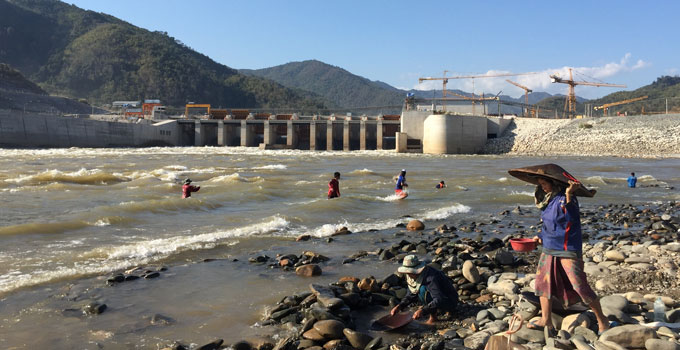
Dams provide many essential benefits – such as water supply, irrigation, power generation, flood mitigation, drought management and recreation – but we must always ensure that these values are carefully balanced against any level of potential risk the dam may pose to its community and environment. When a dam is designed, constructed and operated according to current best practice, it’s highly likely to be safe.
Dam risk is the combination of the chance of dam failure, however small, and the consequence of that failure. We need to ensure that the level of risk is minimised to what is considered ‘acceptable’ by society. This level of risk can then be compared against other risks that society accepts, such as in the aeronautical, chemical or electrical industries.
If a dam has a high hazard (or consequence) category, its chance of failure must be remotely small, ensuring that the risk to society is acceptable. A dam with a higher hazard category requires higher engineering and operational standards. This is a fundamental concept for dam owners and developers, and is crucial to ensure an acceptable dam safety risk.
The only way that the level of hazard can be properly determined is through adequate consideration of the potential downstream consequences of the dam’s failure. The guidelines of the Australian National Committee on Large Dams (ANCOLD) have renamed the ‘dam hazard category’ to ‘dam consequence category’ – highlighting that the hazard category should be based on potential downstream consequences. Regrettably, the dam hazard category given in international dam safety guidelines are still based only around dam height and reservoir volume.
The failure of the saddle dam at the Xe-Pian Xe-Namnoy hydropower project under construction in Laos illustrates that the height of a dam is not the major determining factor of that dam’s hazard category. The fact that this saddle dam was only 16 m high did not make it less of a hazard than the main 78 m high dam.
In some situations, saddle dams can even pose a higher level of hazard than the higher main dams because of the great volume of water stored in the upper part of the reservoir, the lower level of surveillance and emergency planning at the saddle dam than at the main dam, and the fact that water flow downstream is not usually expected from a saddle dam so the population downstream may be larger as well as less aware of potential risks.
So how can we ensure an acceptable level of safety? Here’s our ten-point plan for safer dams
1 – Assess the downstream consequence through dam break modelling
Dynamic hydraulic modelling software can be used to model hypothetical dam failure, quantifying the likely downstream flood wave such an event could generate. Based on this modelling, you can map the flooded area and determine the downstream consequences for life safety, property damage, economic impacts, environmental and heritage damage, and social impacts such as employment, health and wellbeing. Now, the dam’s hazard (or consequence) category can be determined, forming the basis for the design criteria and operational requirements.
2 – Adopt the appropriate design standards for the hazard category
In most international guidelines, the hazard category of the dam determines the design criteria. The greater the downstream consequence, the more stringent the design criteria adopted. However, every dam site is unique, so it is not always possible to design everything according to a general design standard because there simply isn’t a design standard for everything. This requires good engineering judgement. A framework for that judgement is a failure modes analysis for the dam.
3 – Undertake a failure modes analysis
A failure modes analysis identifies the sequence of events that need to occur to lead to dam failure. This process will help to identify the key issues associated with the particular dam site. It will focus the design effort on the elimination of the specific failure modes for the particular dam. It is vital that the dam foundation and reservoir impoundment are considered, and that credible failure mechanisms associated with geological defects are identified and assessed.
4 – Use experienced contractors and ensure quality control
The design engineer must be involved during the construction phase to ensure that the design intent is fully captured and that any changes are carefully considered so that no new failure modes are introduced. Unless the dam is constructed in accordance with the design documentation (the drawings and specifications), there’s no guarantee that the dam will comply with the design criteria and perform as intended.
5 – Implement appropriate dam safety principles during construction
These principles include ensuring adequate flood capacity, dam safety monitoring (especially if water can be stored behind the dam) and dam safety emergency plans. An effective dam safety emergency plan should be active and appropriately updated during all phases of a dam’s life cycle – during construction, first filling, ongoing operation and during major dam upgrades.
6 – Ensure adequate governance through an independent review panel
An independent review panel should be part of any dam engineering project involving a high hazard, to ensure adequate governance and identification of all hazards and potential failure modes. Most large-scale civil projects will encounter the competing demands of time, cost, quality and safety. However, the independent review panel will ensure that no corners are cut in quality or safety in the drive to meet budgets and schedules.
7 – Heighten scrutiny of the dam during unusual events
Unusual events such as the first filling, major floods or major seismic events require increased attention to dam observations and/or measurements. In these circumstances, surveillance needs to be more frequent, via both physical inspections and monitoring with instrumentation. If anything unusual occurs, a response should be initiated through the dam safety procedures in the dam safety management plan. The initial response will be to further understand what is occurring, and determine if it is a dam safety issue or not. It is good practice that dam engineers are involved during unusual events to interpret information and advise the owner.
8 – Maintain an appropriate dam safety program
Long before the dam is filled, the dam safety program should be underway, including operational instrumentation, regular routine inspections, and the personnel and systems in place to make the necessary decisions should any unusual observations occur. Dam engineers can provide ongoing advice to owners when in-house capability is lacking, and can offer an independent set of eyes to ensure currency of the existing systems.
9 – Check your dam safety documentation
Ensure that key dam safety documentation is present, relevant and kept current, including a dam safety management plan, dam surveillance plan, dam operation and maintenance plan, dam safety emergency plan, and evacuation plan.
10 – Consider a dam portfolio risk assessment, regardless of dam size
Even if you think a dam is unlikely to create a high risk, it is worthwhile confirming this, so that you can ensure the appropriate level of dam safety management. If you own a portfolio of dams and you are not sure whether you are exposing society to an unacceptable risk, you should consider a dam portfolio risk assessment to confirm the safety status across your suite of assets. As we’ve indicated, small dams don’t necessarily mean smaller risks .
Running a portfolio risk assessment across numerous small dams may indicate that some have more than a negligible risk, particularly in terms of their criticality to the business or previously unidentified life safety risks. These small dams can then be rolled into your broader dam safety program to ensure that, despite their small size, they are assessed, operated and maintained in alignment with their risk, as for your larger dams.
Whatever the size or purpose of your dam, safety needs to remain your top priority. These ten steps form a best-practice pathway so you can be sure that you’re doing everything possible during dam design, construction and operations to minimise the chance of dam failure and its downstream consequences.
To discuss how Entura can support your dam safety activities, please contact either Richard Herweynen on +61 3 6245 4130 or Shekhar Prince on +61 412 402 110.
About the authors
Richard Herweynen is Entura’s Technical Director, Water. Richard has three decades of experience in dam and hydropower engineering, and has worked throughout the Indo-Pacific region on both dam and hydropower projects, covering all aspects including investigations, feasibility studies, detailed design, construction liaison, operation and maintenance and risk assessment for both new and existing projects. Richard has been part of a number of recent expert review panels for major water projects. He participated in the ANCOLD working group for concrete gravity dams and is the Chairman of the ICOLD technical committee on engineering activities in the planning process for water resources projects. Richard has won many engineering excellence and innovation awards (including Engineers Australia’s Professional Engineer of the Year 2012 – Tasmanian Division), and has published more than 30 technical papers on dam engineering.
Paul Southcott is a specialist civil engineer at Entura. He has more than 28 years of professional expertise in civil and dam engineering, as well as expertise in geotechnical, foundation, structural, hydraulic and hydropower engineering. Paul’s dam engineering experience spans geotechnical and hydrological investigation; feasibility and options studies; concept, preliminary and detailed design; engineering assessment, consequence assessment and risk assessment; safety reviews; monitoring and surveillance; and emergency planning. He has extensive experience in dam risk assessment including as project manager for Hydro Tasmania’s, Taswater’s and SAWater’s portfolio risk assessment projects. He was a member of the ANCOLD committee that issued the Guideline on Consequence Categories for Dams in 2012.
MORE THOUGHT LEADERSHIP ARTICLES
What can dam owners do to better manage floods and avoid the blame game?
To keep communities and assets safe during flood events, dam operators need to make rapid and difficult decisions. The best protection is having the right systems in place before an emergency arises.
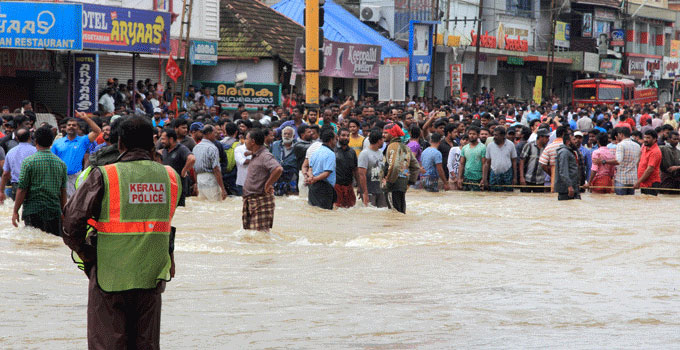
Dam operators are sometimes blamed for causing flood disasters due to the way the dam was operated during intense rains, such as by suddenly releasing water through gates and valves. Yet this criticism is not always warranted, as these actions may have only been one part of the problem associated with the flood. At times, sudden releases may be necessary to maintain the safety of the dam, as the dam’s failure would have even greater consequences than the additional flooding due to the releases.
In 2010 and 2011, Australia experienced some of its biggest flood events, with large areas of Queensland declared disaster zones. At the time of the Queensland floods, there was significant scrutiny of how Wivenhoe Dam was operated, even though it was part of the engineering system designed to mitigate flood risks. Blame and criticism abounded. Individual flood operations engineers were criticised for making poor decisions. The managers of the dam operator were blamed for not drawing down the dam at the beginning of the wet season despite a long drought immediately prior to the floods. The Bureau of Meteorology was criticised for not providing adequate warnings and for inaccurate forecasts. Planners were blamed for allowing development in flood-prone areas. Local authorities and engineering consultants were harshly scrutinised for their modelling and analyses.
Fast forward to 2018, when devastating floods in Kerala, India, resulted in significant loss of life, displacement of people and extensive damage. In this circumstance, blame has been directed at the dam operators, government authorities, planners, flood forecasters, and dam management bodies. Media articles have called it a ‘man-made disaster’, and claims have been made that water should have been discharged earlier from the reservoirs prior to the monsoon, that gates should have been opened gradually, that better warning should have been provided, that power stations should not have been out of action due to maintenance, and that other dam functions such as water supply and power generation should have been secondary to flood mitigation.
Decision-making about dams can be complex, especially given that most dams have more than one purpose: they may supply water for drinking and irrigation, as well as provide flood mitigation benefits for downstream communities. However, the way a dam is operated for both these purposes may be very different and frequently conflicting. For example, a dam for water supply aims to maximise stored water to safeguard supply during droughts; however, a dam for flood mitigation needs as much free space as possible in the reservoir to mitigate the downstream flood risk. Climate change is likely to increase the conflict between water supply and flood mitigation as more severe droughts and floods are anticipated, which will increase the challenges for dam operators – so it is critical that we learn from events such as these examples from Australia and India.
So what can a dam owner do to better manage a major flood event?
The enquiries and reviews that followed the 2010/2011 floods in Australia overwhelmingly indicated the need for improvements in non-structural measures such as development planning, the production and availability of quality flood management information, emergency response management and community participation. The owner and operator of Wivenhoe Dam also discovered the importance of maintaining up-to-date, clear and unambiguous dam flood operating rules, and the need to follow these flood operating rules at all times.
The following seven elements should be in place for every dam owner who wants to better manage major flood events:
1 – Flood forecasting systems
Flood forecasting is critical for protecting public safety and preserving infrastructure. Effective flood forecasting systems provide accurate and timely warning of impending floods. Longer warning times provide greater opportunity to activate emergency management or evacuation plans and to manage water infrastructure. Although the intent of a flood forecasting system is to provide the most accurate forecasts possible, the reality is that there are limitations, especially during major flood events. Reviews undertaken of the 2010/2011 Queensland floods indicated issues with flood data collection and the need for improvements in the coverage of warning networks.
Flood forecasting depends on the timely availability of high-quality data from the right locations in a catchment. Without good real-time telemetered rainfall and streamflow data it will be difficult to develop a dependable flood forecasting system that can be used for real-time decision-making. There needs to be some redundancy in the system because some of the instruments and/or communications systems may fail during a major flood event. This requires an investment both to install and to maintain these instruments. With numerical weather forecasts increasingly available, there is now an opportunity to use this data in flood models to provide even longer lead times for action.
2 – Adequate catchment planning
Catchment-scale management is needed to manage flood risks. Developing flood inundation maps and understanding the consequences of upstream dam failures provide an opportunity for appropriate land use and planning controls downstream, minimising loss of life and property. These tools also provide a basis for developing appropriate structural and non-structural flood mitigation measures and emergency management plans.
3 – Operational model for dam infrastructure
A dam operator needs an operational model that is either linked to the flood forecasting model or embedded in it. If the river system has a cascade of dams, the entire cascade should be modelled as one system, as the operation of each dam affects other linked dams. Understanding these complexities will be critical when managing a major flood event, so that cascade impacts can be assessed and determined prior to implementing an action. Maximum flood mitigation can be achieved by operating linked dams together. Outside of a flood event, these operational models can be used to run potential flood scenarios to help develop clear operational procedures guiding the operation of the dams during a flood event and to train operators so they understand their critical role.
4 – Clear operational procedures for dams during flood events
Given the potential significant impacts on communities downstream, it is imperative that dams are operated during flood events in accordance with clearly defined operational procedures to protect the structural safety of the dams and minimise impacts to life and property. Importantly, all operational decisions during flood events must be documented when they are made, not retrospectively. Pre-releases may be part of these operational procedures, including seasonal targets for reservoir levels to help mitigate flood risks associated with a defined wet season.
Certain triggers (e.g. reservoir level, flood predictions) will shift normal reservoir operation to flood operation. Given infinite possible flood scenarios, it is not always possible or appropriate to provide completely prescriptive flood operating procedures. The manual of operational procedures must be designed to guide decision making based on professional judgements by qualified engineers, ensuring the decisions are robust for all circumstances. When making decisions about releasing water from dams during flood events, consideration should be given to rain falling in catchments not controlled by the dams. Operational decisions must be linked back to the wider flood forecasting system.
5 – Dam safety emergency plans
All high-hazard dams should have a dam safety emergency plan (DSEP, or sometimes called an emergency action plan, EAP), which forms an important part of the overall dam safety management procedures and dam safety documentation. The purpose of a dam safety emergency plan is to provide procedures for the dam owner to manage the dam during an emergency (whether flood, earthquake, or major dam safety incident). The plan needs to clearly outline who does what and when and usually has graded levels of response as the incident develops. A major flood event should trigger the procedures of the dam safety emergency plan, providing a heightened level of awareness of the performance and safety of the dam.
It is important that this plan has clear roles and responsibilities and clear communication channels both internally and externally to emergency services and the media. Clearly documenting the decisions and communications throughout the emergency is critical, and all involved should keep detailed logs of events. This allows effective debriefing after the event to identify improvements to the plan and, in the worst case, will assist in defending any legal action. If at any point the dam is at risk of failure, a dam safety emergency will be declared and emergency services must commence evacuation.
6 – Flood evacuation plans and flood management centre
Flood evacuation is generally the responsibility of the affected state or district’s emergency services. Flood evacuation plans are prepared as part of the planning process for mitigating the risk associated with a major flooding event. Floodplain mapping forms a part of any flood evacuation plan. These maps show the area that will be flooded in various magnitudes of floods.
Evacuation plans will determine when people need to be evacuated and by what routes, before these evacuation routes are flooded. They will clearly nominate where evacuation centres will be set up on non-flood-prone land with necessary food, water and sanitary facilities. Setting up a centralised flood management centre will help to provide a focal point for information, communication and decision-making throughout the flood event, ensuring clear governance, oversight, roles, responsibilities, communication and cooperation.
Severe flooding is likely to disrupt power and communication systems so available back-up need to be planned, including portable generators, radios and satellite phones. Modern communication tools such as mobile phones are increasingly allowing widespread communication of flood warnings, as well as audit trails of warnings so that post-flood reviews can improve emergency management and evacuation procedures over time.
7 – Community education and awareness
Effective flood evacuation is only possible if the downstream community is aware of the risk and the action they need to take following certain warnings. This awareness is best achieved through community information sessions. Working with communities before a disaster strikes will put them in a better position to deal with its impacts. The 2010/2011 Queensland floods showed that helping people to become more self-reliant is of benefit if/when emergency services are overwhelmed. To achieve this, flood risk information and flood predictions should be publicly available, along with education and clear communication.
These seven factors are not the sole responsibility of a dam owner; instead, cooperation is needed among authorities, and dam owners should encourage and facilitate this. Using a framework based on these seven components, dam owners will continually improve flood management, better securing the safety of people and property downstream, as well as minimising the likelihood of significant reputational and legal risks.
To discuss how Entura can partner with you to better manage dam safety and flood-related risks, contact Richard Herweynen on +61 3 6245 4130.
About the authors
Richard Herweynen is Entura’s Technical Director, Water. Richard has three decades of experience in dam and hydropower engineering, and has worked throughout the Indo-Pacific region on both dam and hydropower projects, covering all aspects including investigations, feasibility studies, detailed design, construction liaison, operation and maintenance and risk assessment for both new and existing projects. Richard has been part of a number of recent expert review panels for major water projects. He participated in the ANCOLD working group for concrete gravity dams and is the Chairman of the ICOLD technical committee on engineering activities in the planning process for water resources projects. Richard has won many engineering excellence and innovation awards (including Engineers Australia’s Professional Engineer of the Year 2012 – Tasmanian Division), and has published more than 30 technical papers on dam engineering.
MORE THOUGHT LEADERSHIP ARTICLES
Maximising the benefits of GIS for better business decisions
‘Location, location, location!’ It’s a familiar catch-phrase in the real estate industry, but it’s just as relevant in the power and water sector. Wherever there’s location-related data, a geographic information system will guide better business decisions.
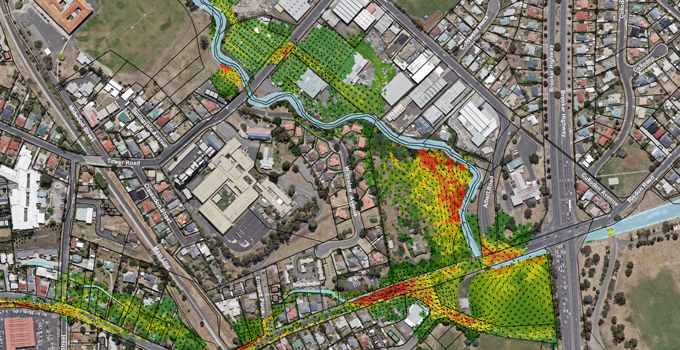
Mobile devices and apps are increasingly using location-based data collected via satellites, drones, LIDAR and other rapidly developing sensing and data capture technologies. With these advances, we are able to find relevant information more quickly and draw on that information to make informed decisions. We’re seeing this proliferate in everyday life through apps that help us navigate, find services and products, and make decisions ranging from the trivial to the profound.
Developers and managers of power and water infrastructure projects who embrace GIS (geographic information systems) stand to gain benefits on an even greater scale. Gathering high-quality spatial information and analysing it to guide business decisions will certainly improve productivity and the bottom line.
Better decisions are the necessary foundation for increased revenue, lower costs, greater efficiency and productivity, and reduced risks. So, if the technology is available and there’s so much to gain, why isn’t GIS being as widely used in the power and water sector as it could be? What may be holding businesses back from fully embracing this powerful and dynamic technology?
Do we really need to use GIS for this project?
All power and water projects involve location – from finding an optimum site for your project, to analysing combinations of spatial data to make the best management decisions or to predict events. Whenever you ask a ‘where?’ question, GIS can help. Where is the asset best located? Where are the constraints or hazards? Where are the reports of previous work done in this area? Where are the customers or opportunities?
In other words, rather than asking whether GIS is needed on a project, consider making GIS a default for every project. The real question should be “how can we maximise the benefits of using spatial data and GIS on this project?” GIS can offer business benefits far beyond the most commonly understood use: making a map.
Data capture in the field can now be streamlined – gone are the days of capturing field data with pen and paper. Users can now collect data on mobile devices, sync to databases while in the field, share data, and generate their own maps, queries and reports. Embracing these advances will save time and enable faster and better decisions.
As well as providing valuable business insights, spatial analysis and location intelligence can greatly improve communication and knowledge sharing – within project teams, with the broader business, and with the community and stakeholders – via tools such as web maps and apps, visual analysis and 3D modelling.
One of the most important applications is the simultaneous analysis of different spatial datasets to provide the best solutions or choices between alternative options, locations, objects and so on. This process is better known as multi-criteria analysis (MCA) and it can be used for many applications.
For example, MCA can be used to find the optimum site for your project taking into account a range of values such as local geology, threatened species, resource availability, land use and terrain, planning restrictions, communities and demographics. Using MCA, you can establish areas of best fit for your project based on thematic overviews of areas of constraint, cost of construction, access and transportation routes.
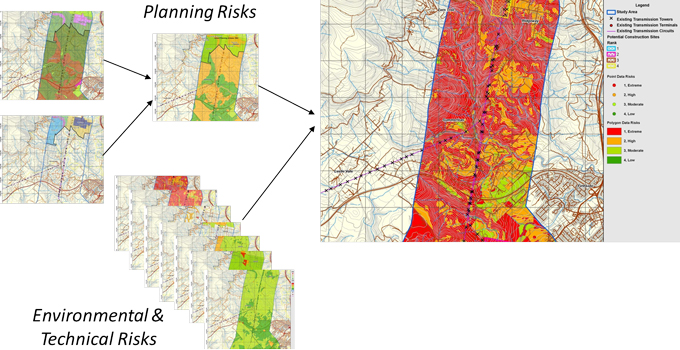
Risks such as bushfire, weeds, threatened species, pollution sources, landslides and erosion can also be more easily and fully understood, supporting your ongoing site management of such issues.
GIS also links with document management, asset management, business intelligence and enterprise resource planning (ERP) systems. It can act as a portal, creating a central point of easy access, pulling together information and making it available on one of the simplest forms to interpret – a map.
Of course GIS is not the answer to everything, and it is not a standalone platform. However, there’s much it can offer across many different business activities, working together with other business systems.
What about the costs?
The return on investment of using GIS should be positive if it is used appropriately. For site selection of power and water projects, using GIS is a no-brainer. For example, using GIS to find the best site for a wind farm – locating the best winds, minimal constraints, good proximity to existing infrastructure and appropriate land use – will obviously result in vastly greater returns than siting the wind farm in an inferior location.
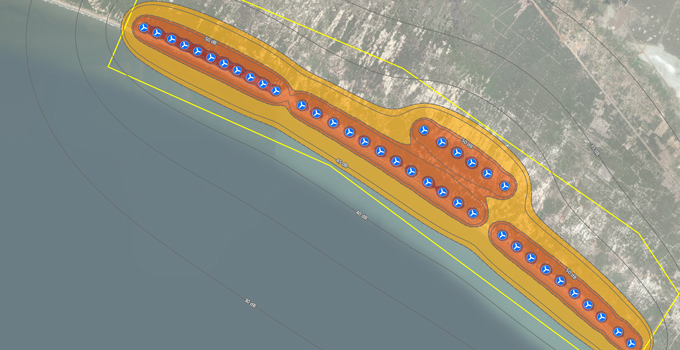
Some examples may be less immediately apparent, but equally valuable – for example, using GIS to increase efficiencies in everyday workflows. If your workers are taking an extra half hour every time they need to find previous work completed in an area, this time can add up quickly. Or perhaps they can’t find previous information, so work is re-done unnecessarily. These costs will keep adding up. Instead you could use a GIS web map to locate all your previous reports and projects, so that a simple click on a map finds the files and saves hours (if not days) of time.
Do we need specialist software or skillsets?
With most things, you do need specialised skillsets and software to get good results, and of course bad data in equals bad data out. Users of GIS do need to understand and assess the spatial data needs in each application.
You could undertake some GIS work yourself using free or open-source software. However, be aware of the risks of using data or tools that aren’t fit for purpose. Just because you know how to use Microsoft Word, doesn’t mean you could write a detailed report outside your area of expertise!
We have seen cases where coarse-resolution data has been used to infer finer project details and costs, resulting in poor decisions. We have also seen inexperienced operators make invalid assumptions. To get the best results, you need to be sure that you’re using the technology wisely.
If you are engaging a power, water or environmental consultant on a project, they are likely to have access to GIS capability; however, GIS is still often underutilised. When deciding who to engage on your project, ask your consultant how they will maximise the benefits of GIS to produce better outcomes for your project.
To discuss how Entura can help you harness the potential of GIS to improve your power and water project decisions and outcomes, contact Stephen Thomas on +61 3 6245 4511, Patrick Pease or Phillip Ellerton on +61 439 010 172.
About the authors
Stephen Thomas is Team Leader and Senior Technical Officer with Entura, specialising in geographic information systems, 3D visualisation and CAD software. Steve has over twenty-six years of technical experience and specialises in environmental assessments and approvals for engineering surveys and property. He has created 3D models and animations of proposed developments including wind farms, urban landscapes and city frameworks. Steve’s work on the Hobart Waterfront 3D model won an international award in geospatial modelling.
MORE THOUGHT LEADERSHIP ARTICLES
Six sink-or-swim questions for the modern dam engineer
Technology and expectations are constantly evolving for the dam engineer but the ultimate goal remains the same: safe, lasting dams. Are you fully equipped to make that target a reality?
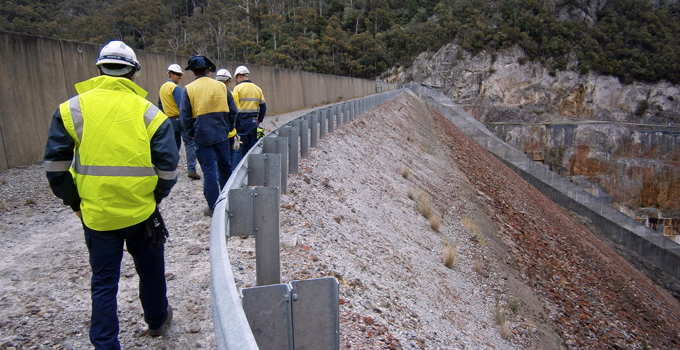
All industries and jobs change over time, but for dam engineers there has been very significant change on many fronts over the last few decades. Improvements and new developments in technology and construction methods are constantly emerging. Expectations of the role continue to broaden beyond technical skills. And, since the 1970s and 1980s, dam engineers have needed to keep abreast of the surge in legislation, regulations and procedures for modern dam safety programs which emerged in the wake of major dam failures.
Of course, generational change is also always occurring. For organisations that have experienced bubbles and dips in the age distribution of their workforce, this is particularly challenging, and gaps may emerge in particular experience brackets. As older engineers move towards retirement, they take with them the knowledge of the generation who designed and constructed older dams that may still retain original technology.
The modern dam engineer therefore faces a dual challenge: not only to stay up to date with the latest technology and requirements, but also to maintain an understanding of older equipment and instruments.
For dam owners and managers, success in your business strategy will depend on ensuring that your dam engineers have the right skills and competencies. Investing in workforce planning and training for your people will help you manage risk, deliver your key functions, and move toward your long-term business goals.
To me, the following key factors are essential for the modern dam engineer to keep on top of our fast-changing profession.
1 – Are you keeping up with changing technology for dam engineering and monitoring?
Dam engineering and monitoring technology keeps improving, and the pace of change gets faster all the time. Defensive measures to ensure the safety of dams have improved greatly over recent decades, such as filters for internal erosion protection, and corrosion protection in ground anchors.
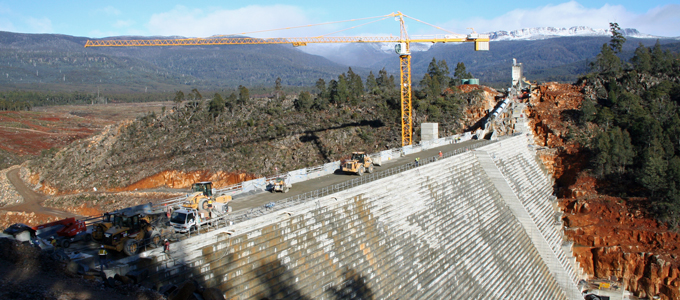
Methods for analysing dams have also become more sophisticated with increased computing power and more advanced analysis software, in particular for extreme floods and non-linear analysis for seismic loading. The modern dam engineer also has access to contemporary geotechnical and structural monitoring instruments, which are useful for interpreting the behaviour of a dam.
It is no longer acceptable for a dam safety engineer to rely only on visual inspection and monitoring data. Modern dam engineers need to understand the underlying design philosophy and keep up with the latest construction practices and their impacts on dam behaviour. We also need to maintain an enhanced understanding of the performance of dam structures and appurtenance structures under various load conditions.
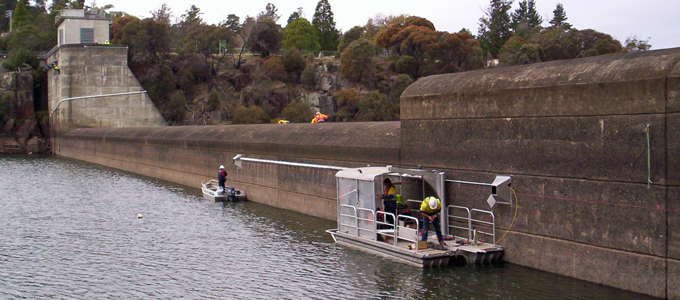
In recent years, advanced instruments and automated data acquisition systems have enabled real-time monitoring of dams and near-continuous time history records for the dam engineer to evaluate.
Dealing with this great volume of data can be very time-consuming and beset by a range of challenges, so it is important that the modern dam engineer embraces the best technological advances to streamline the collection, organisation, interpretation and presentation of the data so that it serves its ultimate function: to quickly identify pertinent issues or anomalies.
2 – Are you guided by risks, with a thorough understanding of failure modes?
The modern dam safety engineer needs a thorough understanding of dam safety risks and assessment practices. Risk assessment now defines the dam surveillance scope and program, and failure modes analysis forms the foundation of a risk-based dam safety and surveillance program.
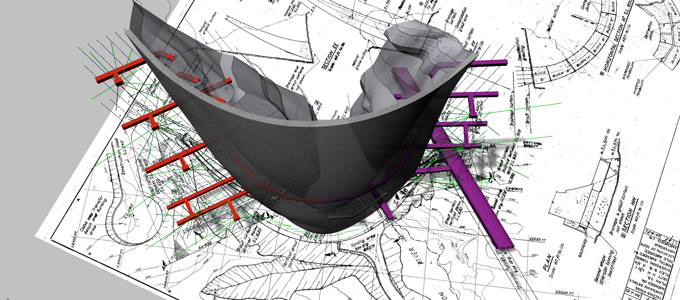
When assessing failure modes, the dam engineer needs to work alongside geologists and construction engineers to understand the impact of construction and to identify features that are not readily visible through visual inspections but could affect the safety of a dam.
3 – Do you consider and understand the impacts of environmental changes?
For dam engineers, consideration of environmental factors is nothing new. However, the potential for changes in weather patterns, and the consequences of these changes, are increasingly important concerns for the modern dam engineer.
In an era in which the climate is changing, dam engineers now need to, for example, consider changes in the size and frequency of rare flood events when evaluating the required spillway capacity, or investigate the adverse impacts on embankment dams during long periods of low rainfall, which could cause desiccation and cracking of the clay material.
4 – How do you prioritise activities within constrained budgets?
Some large dams are now more than 50 years old and are in disrepair or inadequately monitored. However, the limited budgets of public and private sector dam owners can constrain their ability to fund comprehensive surveillance programs and dam remediation works.
This places increasing pressure on the modern dam safety engineer, who should recommend a prioritised program of risk-reduction work within the context of the owner’s financial constraints, to ensure that risks are adequately managed.
5 – Can you engage effectively with the dam’s community and stakeholders?
Dam engineers are increasingly required to consider the safety of dams in the context of the community’s cultural and heritage interests. Community scrutiny of the safety of a dam, or of planned works to improve safety, continues to increase.
With the advent of social media, public scrutiny is now immediate, constant and global. This is a challenge for modern dam engineers, who are not often trained in community engagement.
6 – How safe are your practices?
Over the past two decades, workplace health and safety requirements have had a significant impact on dam engineering. Although not a new responsibility, the regulatory requirements to ensure safe construction, operation, maintenance and decommissioning have increased, requiring modern dam engineers to be aware of legal requirements and safety standards beyond their core skills.
In a world in which the availability and uses of water are increasingly in demand and under strain, we need safe, reliable, enduring dams. Investing in the skills and competencies of modern, professional dam engineers is a critical step towards achieving that goal.
If you would like to talk further about developing your dam engineers, or filling gaps in your own expertise, contact Richard Herweynen, Phillip Ellerton or Dale Bryce.
MORE THOUGHT LEADERSHIP ARTICLES
Keeping safe around dams
When we hear ‘dam’ and ‘safety’ in the same sentence, it’s natural to think first of catastrophic dam failures and their devastating impacts on downstream communities. However, keeping the public safe around dams also involves considering and mitigating some more common and less documented risks…
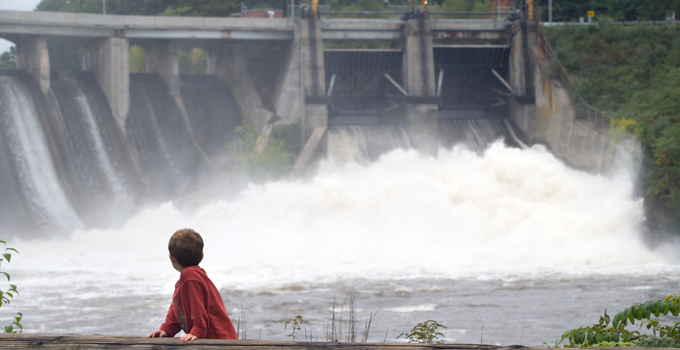
Dams, water courses and water bodies typically offer a range of recreational benefits enjoyed by many. But where there’s water, there’s inherent danger, including the risk of drowning.
Asset managers know much more about the numbers of fatalities relating to dam failures than about the fatalities associated with the overall ongoing presence and operation of dams. But we do know that drownings in dams and waterways make up more than a third of total drowning statistics in Australia, and the situation is similar around the world.
Regardless of the specific circumstances of each of these fatalities, it is clear that owners and regulators of dams and water courses need to take action to help protect the public from these largely avoidable deaths.
In 2012 the International Committee on Large Dams established a working committee to start identifying these public safety risks, describe the international state of practice to manage and mitigate the risks, and develop a guidance bulletin on best practice measures and public education about safety around dams. This project is well underway, and here I’ll take a look at some of the key risks and possible mitigations being considered.
WHAT ARE THE RISKS?
The general public tends to underestimate the hazards linked to activities around dams and waterways, particularly the possibility and effects of sudden changes in water level and flow.
Accidents may happen around dams and water bodies during a range of activities – not only those considered more overtly dangerous (such as abseiling or rock climbing), but also during activities such as swimming, kayaking, boating or fishing. Falls from heights and other activities not associated with access to water are also of concern.
However, many drownings are due to the particular risks relating to hydraulic structures and the inherent nature of their operation, and to rapid changes in water levels and conditions.
Hazards around dams are often associated with swift and turbulent currents near intakes and spillways. These currents may be created by the changes in flows and water levels during normal operations of spillways or during flooding. Unexpected rapidly rising water levels can result from weather conditions, but also from sudden changes in output from hydropower stations, and have the potential to cause people to be inundated or swept away.
Around the world, a large proportion of drownings have been associated with a particular subset of hydraulic structures referred to as ‘low-head weirs’. Under certain flow conditions, these can display a particularly dangerous hydraulic phenomenon, earning them a common description as ‘drowning machines’. This type of structure has particularly attracted attention, and has been investigated, in the United States as it constitutes a large proportion of preventable death in a number of states.
WHAT CAN DAM OWNERS DO?
Where people are undertaking recreational activities with a recognised level of risk, there is an implied responsibility to observe regulations and warnings, take common safety precautions, and be capable and in a suitable state to undertake the activity.
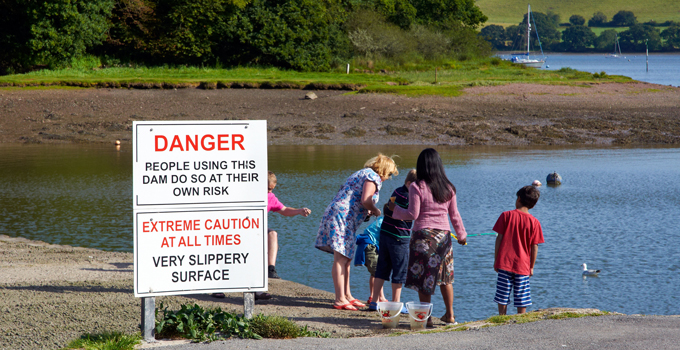
However, the absence of such behaviours does not remove the liability of the asset owner or manager. In fact, their responsibility is even higher in inherently hazardous site conditions, conditions posing a hazard that is not readily identifiable, or where changes in operations lead to changes in the hazard level.
So, what actions should a dam owner or manager take to best protect the public? While not all incidents can be avoided, the possible actions below form a comprehensive approach to minimising risk and reducing probability and consequences.
| Develop a public safety policy and plans, ensuring compliance with laws and regulations |
Start by documenting your commitment to public safety in a policy statement identifying your statutory and legal requirements, and establishing your objectives, tolerance criteria and targets. Translate your policy into a public safety management plan indicating how you will manage the public safety risk at each site. This should be based on a risk assessment of the facility, identifying the hazards, assessing the degree to which the public is exposed, identifying appropriate control measures and assigning responsibilities. |
| Conduct a risk assessment, incorporating comprehensive local insight and regular review |
The risk assessment process is an important step in managing public safety risk as well as complying with statutory and common law obligations. It helps focus on the risks that really matter. Most organisations have an accepted method for analysing, assessing and managing risk; this may be tailored to incorporate public safety risks. Consider such factors as seasonal and daily weather effects. For example, during summer, or other periods of low flow, the public may anticipate a lower likelihood of rapidly changing conditions. There may also be a general lack of awareness that spills can result from other factors than adverse weather, such as changes in generation or earlier precipitation upstream. The quality of the risk assessment and the effectiveness of control measures depend on the degree of site-specific knowledge which is best obtained from staff working at the location or engaged in its operation. The risk assessment should be periodically reviewed to ensure the assumptions remain valid. |
| Exclude the public where necessary through fencing, gates, artificial and natural barriers |
The selection of exclusion devices and layout depends on the particular site and requires input from people with a good local understanding. Note that the effectiveness of public exclusions can vary over time as usage of an area changes or as the public becomes complacent or desensitised to the hazards. |
|
Warn the public of dangers and of changed conditions through signage and other audible and visual alarms
|
Signage and alarms warn of changes in operations (e.g. gate opening) and conditions (e.g. water level or flow). Carefully consider their placement, maintenance, language, readability, and use of terms and symbols. In some circumstances, audible and visual alarms may be appropriate. As with physical barriers, over time the effectiveness of warnings may diminish, particularly if there is a real or perceived lack of connection between the activation of the warning and the occurrence of the hazard. |
|
Educate targeted populations and the general public
|
Best practice suggests that education applied well either via mass media or to targeted populations can have a significant impact. |
| Train supervisory personnel, including in intervention and rescue techniques and incident management |
Training supervisory personnel in hazard identification, risk assessment, compliance assessment and enforcement is important. This can include specific training and simulations in intervention and rescue techniques where appropriate. Many dam owners are reducing the site presence needed to meet operational requirements; but determining the appropriate presence required should take account of the need to maintain a public profile and awareness of public interaction. Periodic patrols are also valuable to identify changed patterns of public use. A public safety incident may be managed by local intervention or could escalate into an emergency, crisis or disaster for an operator depending on the nature and scale of the incident. Effective incident management must go beyond the immediate need to contain the incident (e.g. perform a rescue), by also considering the implications for risk assessment, education, and the return to business operations. |
| Decommission the dam where appropriate | In some circumstances, decommissioning may be an appropriate method to reduce risk. Public safety may add weight to a decision based on other business or operational considerations. |
| Monitor, report and review |
Incident reporting relating to public safety around dams is often poorly undertaken and lacking sufficient detail. There are also very few reports of near misses, which can provide important lessons about mitigating risks, and very limited databases or documented case studies available. To improve this situation, the forthcoming guideline from the ICOLD committee will propose an incident reporting process that can be applied by owners and regulators to improve their practices regarding public safety around dams. |
The ICOLD bulletin will form a valuable tool for owners, operators and regulators to manage and mitigate this significant risk area. A good way to start the process is by seeking the assistance of others who have experience in assessing and managing the public interaction with dam and waterway assets.
Every life lost in a dam-related accident is a tragedy. Through these best practice measures, dam owners and managers have a much greater opportunity to help reduce the many hundreds of dam-related fatalities occurring around the world each year.
If you would like to find out more about how Entura can help you improve safety around dams, please contact Phillip Ellerton on +61 439 010 172 or Shekhar Prince on +61 412 402 110.

